Development of Sustainable Home Using Net Zero Energy
VerifiedAdded on 2023/05/30
|42
|7673
|451
AI Summary
This report addresses the recent methods of technology applied in the process of constructing of the zero net energy buildings. It takes note of new materials of construction, energy consumption levels, innovative procedures and technology, renewable energies, reuse and recycling of materials and the management systems in place.
Contribute Materials
Your contribution can guide someone’s learning journey. Share your
documents today.
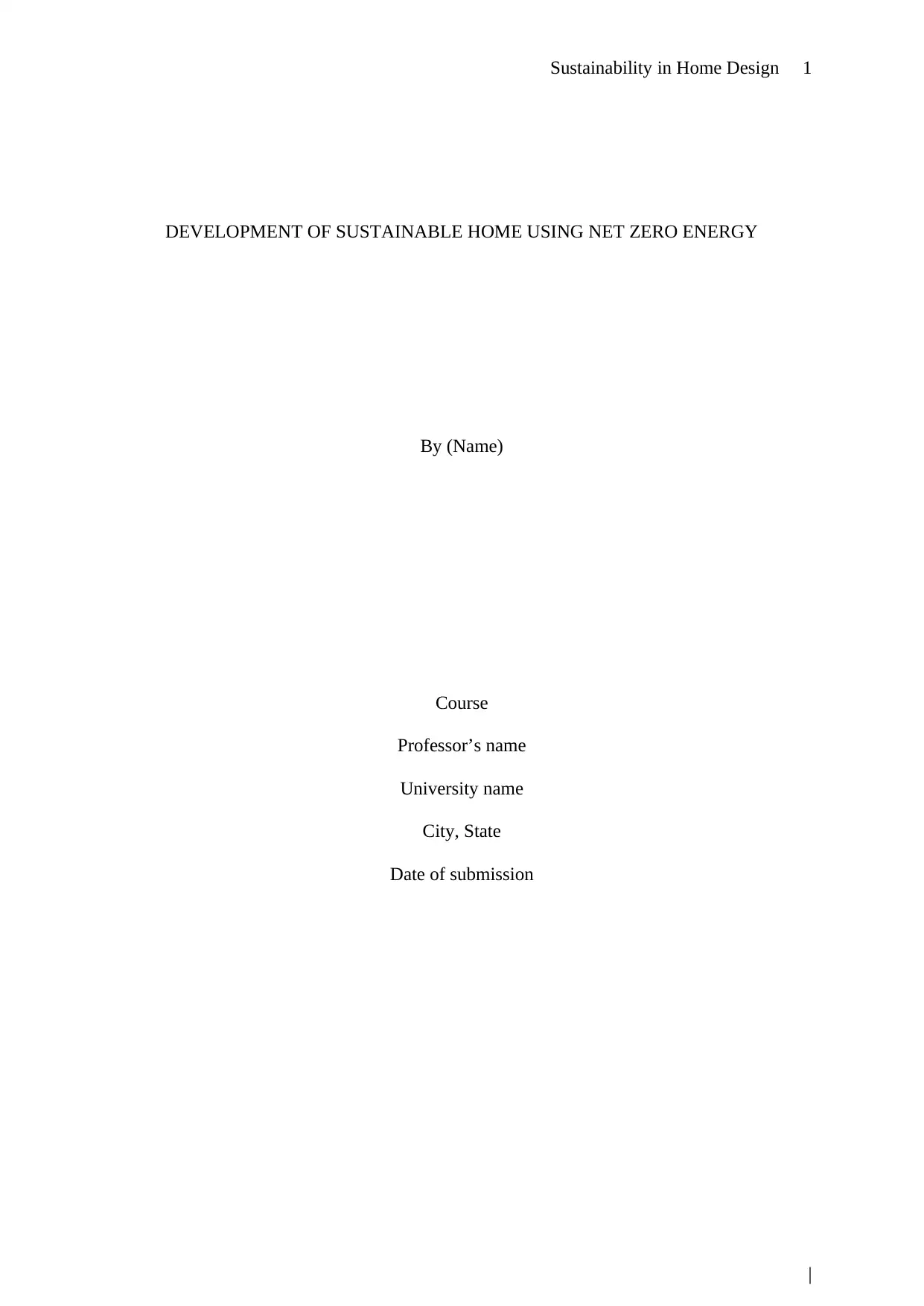
Sustainability in Home Design 1
DEVELOPMENT OF SUSTAINABLE HOME USING NET ZERO ENERGY
By (Name)
Course
Professor’s name
University name
City, State
Date of submission
|
DEVELOPMENT OF SUSTAINABLE HOME USING NET ZERO ENERGY
By (Name)
Course
Professor’s name
University name
City, State
Date of submission
|
Secure Best Marks with AI Grader
Need help grading? Try our AI Grader for instant feedback on your assignments.
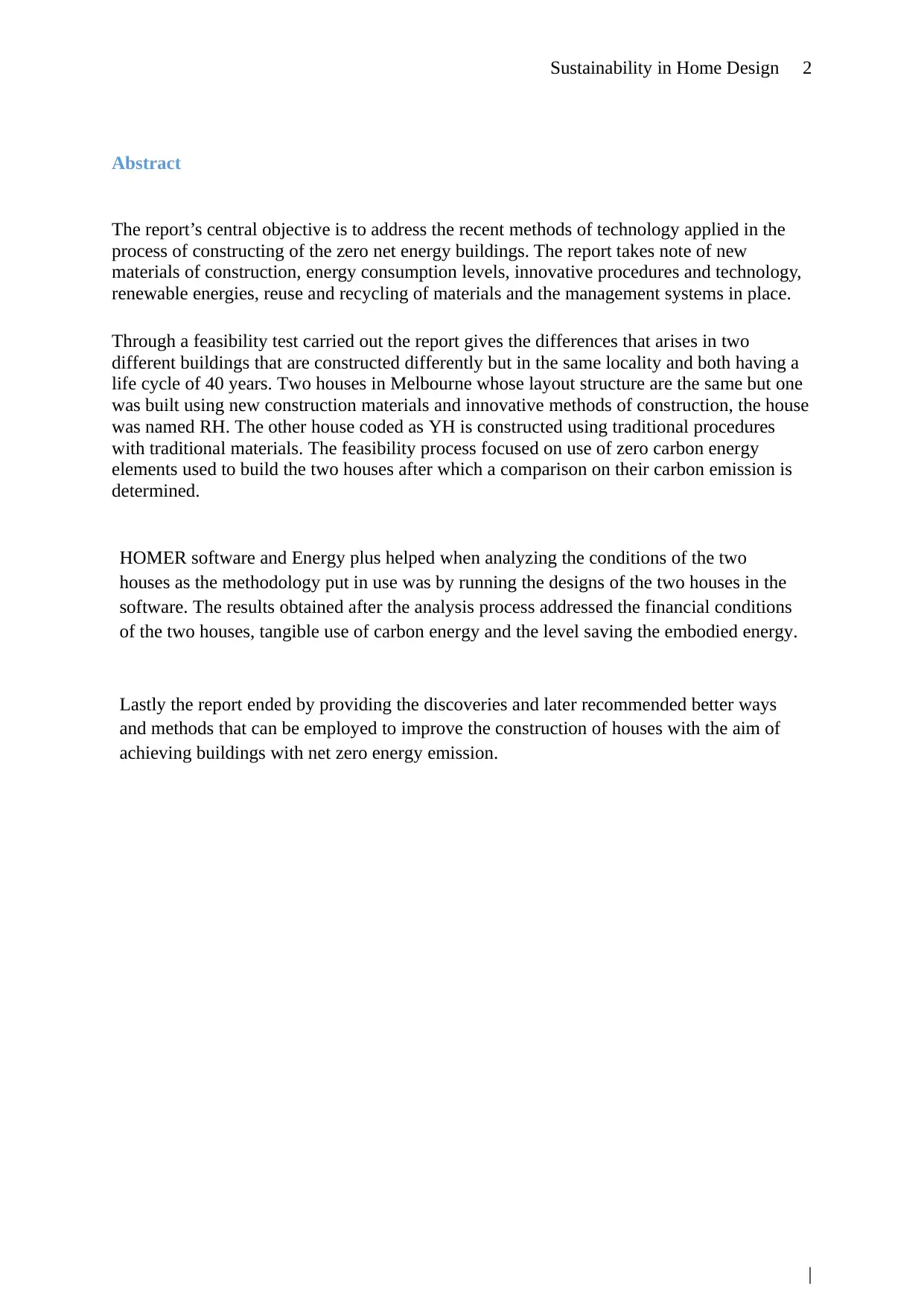
Sustainability in Home Design 2
Abstract
The report’s central objective is to address the recent methods of technology applied in the
process of constructing of the zero net energy buildings. The report takes note of new
materials of construction, energy consumption levels, innovative procedures and technology,
renewable energies, reuse and recycling of materials and the management systems in place.
Through a feasibility test carried out the report gives the differences that arises in two
different buildings that are constructed differently but in the same locality and both having a
life cycle of 40 years. Two houses in Melbourne whose layout structure are the same but one
was built using new construction materials and innovative methods of construction, the house
was named RH. The other house coded as YH is constructed using traditional procedures
with traditional materials. The feasibility process focused on use of zero carbon energy
elements used to build the two houses after which a comparison on their carbon emission is
determined.
HOMER software and Energy plus helped when analyzing the conditions of the two
houses as the methodology put in use was by running the designs of the two houses in the
software. The results obtained after the analysis process addressed the financial conditions
of the two houses, tangible use of carbon energy and the level saving the embodied energy.
Lastly the report ended by providing the discoveries and later recommended better ways
and methods that can be employed to improve the construction of houses with the aim of
achieving buildings with net zero energy emission.
|
Abstract
The report’s central objective is to address the recent methods of technology applied in the
process of constructing of the zero net energy buildings. The report takes note of new
materials of construction, energy consumption levels, innovative procedures and technology,
renewable energies, reuse and recycling of materials and the management systems in place.
Through a feasibility test carried out the report gives the differences that arises in two
different buildings that are constructed differently but in the same locality and both having a
life cycle of 40 years. Two houses in Melbourne whose layout structure are the same but one
was built using new construction materials and innovative methods of construction, the house
was named RH. The other house coded as YH is constructed using traditional procedures
with traditional materials. The feasibility process focused on use of zero carbon energy
elements used to build the two houses after which a comparison on their carbon emission is
determined.
HOMER software and Energy plus helped when analyzing the conditions of the two
houses as the methodology put in use was by running the designs of the two houses in the
software. The results obtained after the analysis process addressed the financial conditions
of the two houses, tangible use of carbon energy and the level saving the embodied energy.
Lastly the report ended by providing the discoveries and later recommended better ways
and methods that can be employed to improve the construction of houses with the aim of
achieving buildings with net zero energy emission.
|
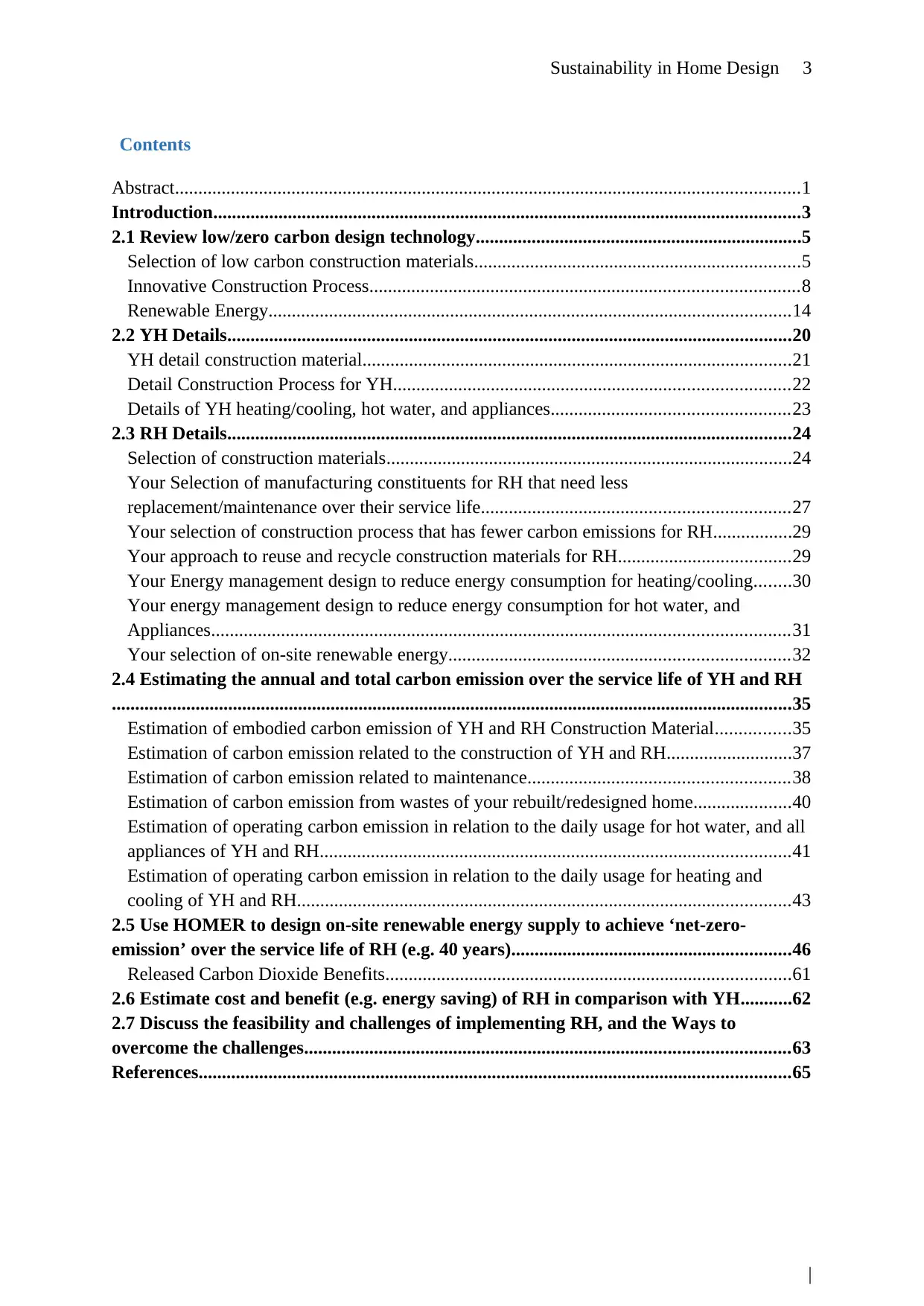
Sustainability in Home Design 3
Contents
Abstract......................................................................................................................................1
Introduction..............................................................................................................................3
2.1 Review low/zero carbon design technology......................................................................5
Selection of low carbon construction materials......................................................................5
Innovative Construction Process............................................................................................8
Renewable Energy................................................................................................................14
2.2 YH Details.........................................................................................................................20
YH detail construction material............................................................................................21
Detail Construction Process for YH.....................................................................................22
Details of YH heating/cooling, hot water, and appliances...................................................23
2.3 RH Details.........................................................................................................................24
Selection of construction materials.......................................................................................24
Your Selection of manufacturing constituents for RH that need less
replacement/maintenance over their service life..................................................................27
Your selection of construction process that has fewer carbon emissions for RH.................29
Your approach to reuse and recycle construction materials for RH.....................................29
Your Energy management design to reduce energy consumption for heating/cooling........30
Your energy management design to reduce energy consumption for hot water, and
Appliances............................................................................................................................31
Your selection of on-site renewable energy.........................................................................32
2.4 Estimating the annual and total carbon emission over the service life of YH and RH
..................................................................................................................................................35
Estimation of embodied carbon emission of YH and RH Construction Material................35
Estimation of carbon emission related to the construction of YH and RH...........................37
Estimation of carbon emission related to maintenance........................................................38
Estimation of carbon emission from wastes of your rebuilt/redesigned home.....................40
Estimation of operating carbon emission in relation to the daily usage for hot water, and all
appliances of YH and RH.....................................................................................................41
Estimation of operating carbon emission in relation to the daily usage for heating and
cooling of YH and RH..........................................................................................................43
2.5 Use HOMER to design on-site renewable energy supply to achieve ‘net-zero-
emission’ over the service life of RH (e.g. 40 years)............................................................46
Released Carbon Dioxide Benefits.......................................................................................61
2.6 Estimate cost and benefit (e.g. energy saving) of RH in comparison with YH...........62
2.7 Discuss the feasibility and challenges of implementing RH, and the Ways to
overcome the challenges........................................................................................................63
References...............................................................................................................................65
|
Contents
Abstract......................................................................................................................................1
Introduction..............................................................................................................................3
2.1 Review low/zero carbon design technology......................................................................5
Selection of low carbon construction materials......................................................................5
Innovative Construction Process............................................................................................8
Renewable Energy................................................................................................................14
2.2 YH Details.........................................................................................................................20
YH detail construction material............................................................................................21
Detail Construction Process for YH.....................................................................................22
Details of YH heating/cooling, hot water, and appliances...................................................23
2.3 RH Details.........................................................................................................................24
Selection of construction materials.......................................................................................24
Your Selection of manufacturing constituents for RH that need less
replacement/maintenance over their service life..................................................................27
Your selection of construction process that has fewer carbon emissions for RH.................29
Your approach to reuse and recycle construction materials for RH.....................................29
Your Energy management design to reduce energy consumption for heating/cooling........30
Your energy management design to reduce energy consumption for hot water, and
Appliances............................................................................................................................31
Your selection of on-site renewable energy.........................................................................32
2.4 Estimating the annual and total carbon emission over the service life of YH and RH
..................................................................................................................................................35
Estimation of embodied carbon emission of YH and RH Construction Material................35
Estimation of carbon emission related to the construction of YH and RH...........................37
Estimation of carbon emission related to maintenance........................................................38
Estimation of carbon emission from wastes of your rebuilt/redesigned home.....................40
Estimation of operating carbon emission in relation to the daily usage for hot water, and all
appliances of YH and RH.....................................................................................................41
Estimation of operating carbon emission in relation to the daily usage for heating and
cooling of YH and RH..........................................................................................................43
2.5 Use HOMER to design on-site renewable energy supply to achieve ‘net-zero-
emission’ over the service life of RH (e.g. 40 years)............................................................46
Released Carbon Dioxide Benefits.......................................................................................61
2.6 Estimate cost and benefit (e.g. energy saving) of RH in comparison with YH...........62
2.7 Discuss the feasibility and challenges of implementing RH, and the Ways to
overcome the challenges........................................................................................................63
References...............................................................................................................................65
|

Sustainability in Home Design 4
Introduction
|
Introduction
|
Secure Best Marks with AI Grader
Need help grading? Try our AI Grader for instant feedback on your assignments.
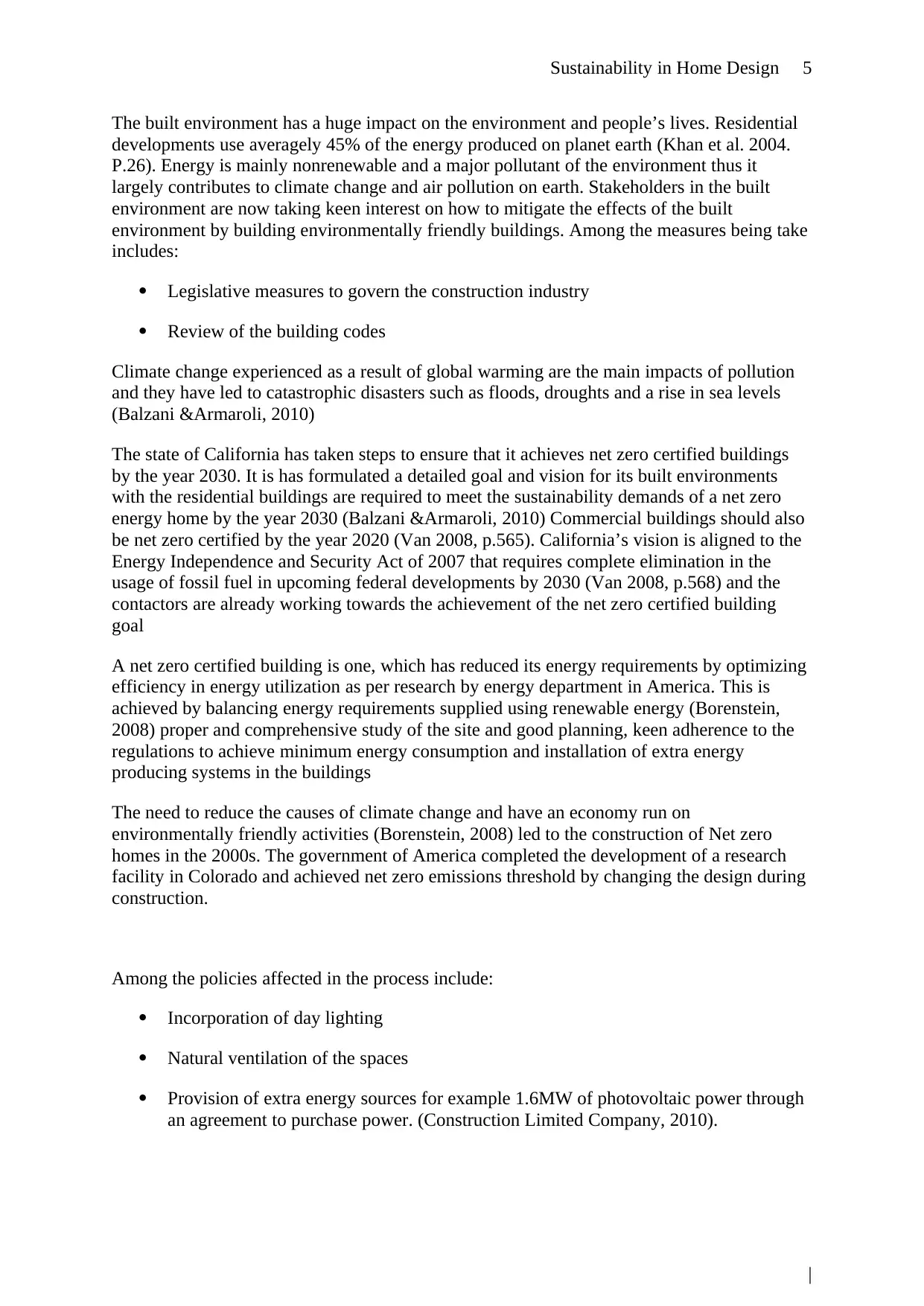
Sustainability in Home Design 5
The built environment has a huge impact on the environment and people’s lives. Residential
developments use averagely 45% of the energy produced on planet earth (Khan et al. 2004.
P.26). Energy is mainly nonrenewable and a major pollutant of the environment thus it
largely contributes to climate change and air pollution on earth. Stakeholders in the built
environment are now taking keen interest on how to mitigate the effects of the built
environment by building environmentally friendly buildings. Among the measures being take
includes:
Legislative measures to govern the construction industry
Review of the building codes
Climate change experienced as a result of global warming are the main impacts of pollution
and they have led to catastrophic disasters such as floods, droughts and a rise in sea levels
(Balzani &Armaroli, 2010)
The state of California has taken steps to ensure that it achieves net zero certified buildings
by the year 2030. It is has formulated a detailed goal and vision for its built environments
with the residential buildings are required to meet the sustainability demands of a net zero
energy home by the year 2030 (Balzani &Armaroli, 2010) Commercial buildings should also
be net zero certified by the year 2020 (Van 2008, p.565). California’s vision is aligned to the
Energy Independence and Security Act of 2007 that requires complete elimination in the
usage of fossil fuel in upcoming federal developments by 2030 (Van 2008, p.568) and the
contactors are already working towards the achievement of the net zero certified building
goal
A net zero certified building is one, which has reduced its energy requirements by optimizing
efficiency in energy utilization as per research by energy department in America. This is
achieved by balancing energy requirements supplied using renewable energy (Borenstein,
2008) proper and comprehensive study of the site and good planning, keen adherence to the
regulations to achieve minimum energy consumption and installation of extra energy
producing systems in the buildings
The need to reduce the causes of climate change and have an economy run on
environmentally friendly activities (Borenstein, 2008) led to the construction of Net zero
homes in the 2000s. The government of America completed the development of a research
facility in Colorado and achieved net zero emissions threshold by changing the design during
construction.
Among the policies affected in the process include:
Incorporation of day lighting
Natural ventilation of the spaces
Provision of extra energy sources for example 1.6MW of photovoltaic power through
an agreement to purchase power. (Construction Limited Company, 2010).
|
The built environment has a huge impact on the environment and people’s lives. Residential
developments use averagely 45% of the energy produced on planet earth (Khan et al. 2004.
P.26). Energy is mainly nonrenewable and a major pollutant of the environment thus it
largely contributes to climate change and air pollution on earth. Stakeholders in the built
environment are now taking keen interest on how to mitigate the effects of the built
environment by building environmentally friendly buildings. Among the measures being take
includes:
Legislative measures to govern the construction industry
Review of the building codes
Climate change experienced as a result of global warming are the main impacts of pollution
and they have led to catastrophic disasters such as floods, droughts and a rise in sea levels
(Balzani &Armaroli, 2010)
The state of California has taken steps to ensure that it achieves net zero certified buildings
by the year 2030. It is has formulated a detailed goal and vision for its built environments
with the residential buildings are required to meet the sustainability demands of a net zero
energy home by the year 2030 (Balzani &Armaroli, 2010) Commercial buildings should also
be net zero certified by the year 2020 (Van 2008, p.565). California’s vision is aligned to the
Energy Independence and Security Act of 2007 that requires complete elimination in the
usage of fossil fuel in upcoming federal developments by 2030 (Van 2008, p.568) and the
contactors are already working towards the achievement of the net zero certified building
goal
A net zero certified building is one, which has reduced its energy requirements by optimizing
efficiency in energy utilization as per research by energy department in America. This is
achieved by balancing energy requirements supplied using renewable energy (Borenstein,
2008) proper and comprehensive study of the site and good planning, keen adherence to the
regulations to achieve minimum energy consumption and installation of extra energy
producing systems in the buildings
The need to reduce the causes of climate change and have an economy run on
environmentally friendly activities (Borenstein, 2008) led to the construction of Net zero
homes in the 2000s. The government of America completed the development of a research
facility in Colorado and achieved net zero emissions threshold by changing the design during
construction.
Among the policies affected in the process include:
Incorporation of day lighting
Natural ventilation of the spaces
Provision of extra energy sources for example 1.6MW of photovoltaic power through
an agreement to purchase power. (Construction Limited Company, 2010).
|
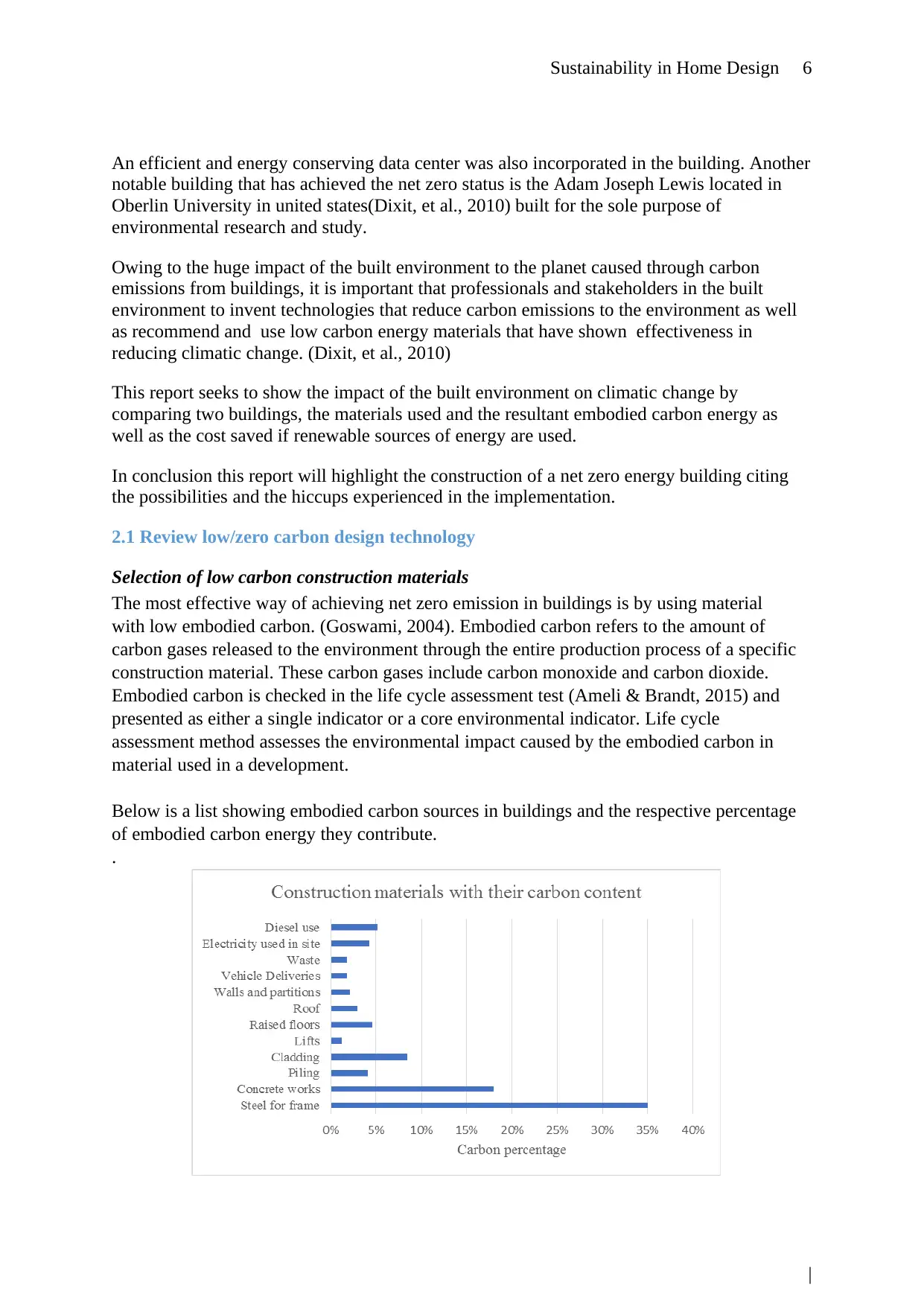
Sustainability in Home Design 6
An efficient and energy conserving data center was also incorporated in the building. Another
notable building that has achieved the net zero status is the Adam Joseph Lewis located in
Oberlin University in united states(Dixit, et al., 2010) built for the sole purpose of
environmental research and study.
Owing to the huge impact of the built environment to the planet caused through carbon
emissions from buildings, it is important that professionals and stakeholders in the built
environment to invent technologies that reduce carbon emissions to the environment as well
as recommend and use low carbon energy materials that have shown effectiveness in
reducing climatic change. (Dixit, et al., 2010)
This report seeks to show the impact of the built environment on climatic change by
comparing two buildings, the materials used and the resultant embodied carbon energy as
well as the cost saved if renewable sources of energy are used.
In conclusion this report will highlight the construction of a net zero energy building citing
the possibilities and the hiccups experienced in the implementation.
2.1 Review low/zero carbon design technology
Selection of low carbon construction materials
The most effective way of achieving net zero emission in buildings is by using material
with low embodied carbon. (Goswami, 2004). Embodied carbon refers to the amount of
carbon gases released to the environment through the entire production process of a specific
construction material. These carbon gases include carbon monoxide and carbon dioxide.
Embodied carbon is checked in the life cycle assessment test (Ameli & Brandt, 2015) and
presented as either a single indicator or a core environmental indicator. Life cycle
assessment method assesses the environmental impact caused by the embodied carbon in
material used in a development.
Below is a list showing embodied carbon sources in buildings and the respective percentage
of embodied carbon energy they contribute.
.
|
An efficient and energy conserving data center was also incorporated in the building. Another
notable building that has achieved the net zero status is the Adam Joseph Lewis located in
Oberlin University in united states(Dixit, et al., 2010) built for the sole purpose of
environmental research and study.
Owing to the huge impact of the built environment to the planet caused through carbon
emissions from buildings, it is important that professionals and stakeholders in the built
environment to invent technologies that reduce carbon emissions to the environment as well
as recommend and use low carbon energy materials that have shown effectiveness in
reducing climatic change. (Dixit, et al., 2010)
This report seeks to show the impact of the built environment on climatic change by
comparing two buildings, the materials used and the resultant embodied carbon energy as
well as the cost saved if renewable sources of energy are used.
In conclusion this report will highlight the construction of a net zero energy building citing
the possibilities and the hiccups experienced in the implementation.
2.1 Review low/zero carbon design technology
Selection of low carbon construction materials
The most effective way of achieving net zero emission in buildings is by using material
with low embodied carbon. (Goswami, 2004). Embodied carbon refers to the amount of
carbon gases released to the environment through the entire production process of a specific
construction material. These carbon gases include carbon monoxide and carbon dioxide.
Embodied carbon is checked in the life cycle assessment test (Ameli & Brandt, 2015) and
presented as either a single indicator or a core environmental indicator. Life cycle
assessment method assesses the environmental impact caused by the embodied carbon in
material used in a development.
Below is a list showing embodied carbon sources in buildings and the respective percentage
of embodied carbon energy they contribute.
.
|
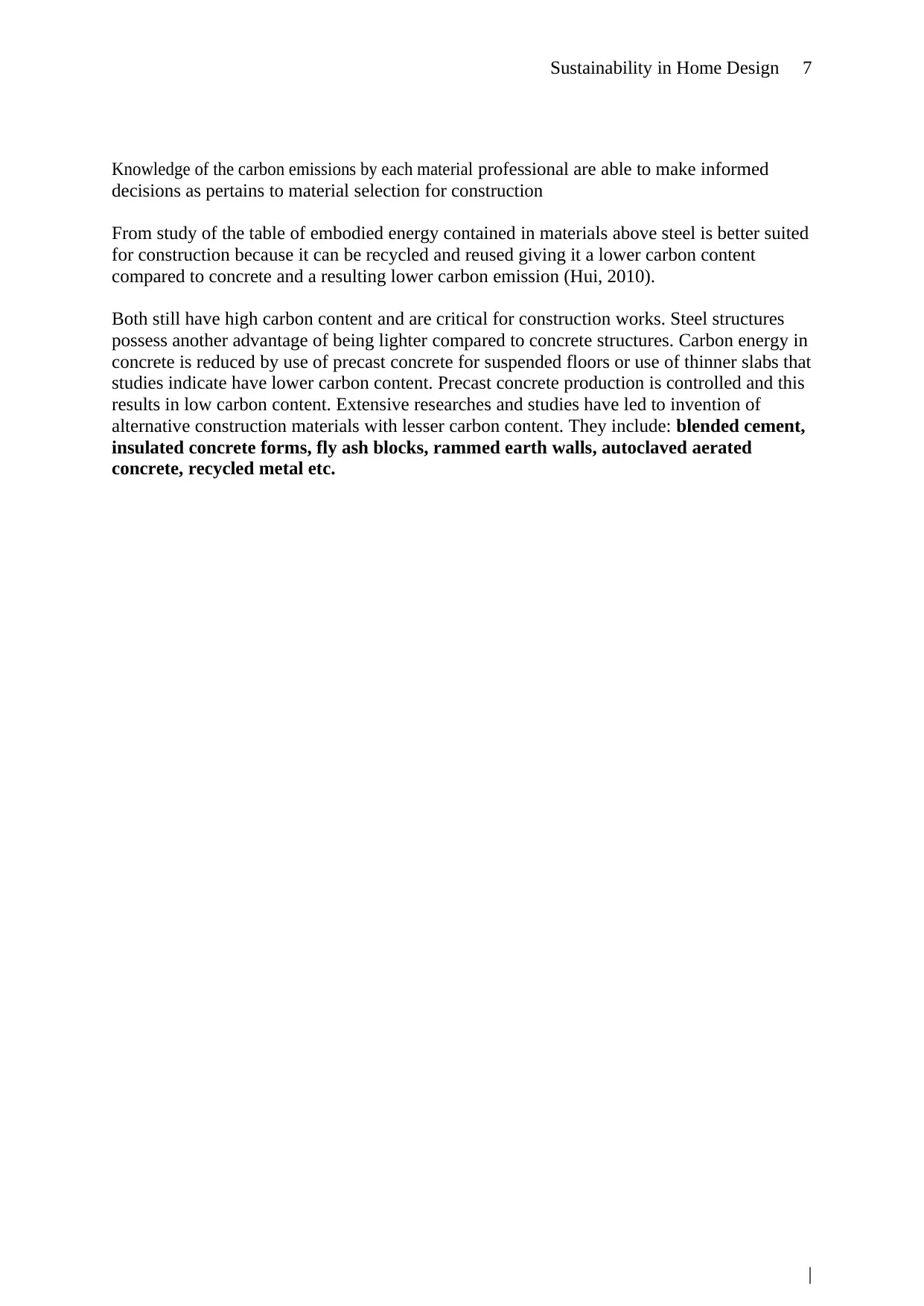
Sustainability in Home Design 7
Knowledge of the carbon emissions by each material professional are able to make informed
decisions as pertains to material selection for construction
From study of the table of embodied energy contained in materials above steel is better suited
for construction because it can be recycled and reused giving it a lower carbon content
compared to concrete and a resulting lower carbon emission (Hui, 2010).
Both still have high carbon content and are critical for construction works. Steel structures
possess another advantage of being lighter compared to concrete structures. Carbon energy in
concrete is reduced by use of precast concrete for suspended floors or use of thinner slabs that
studies indicate have lower carbon content. Precast concrete production is controlled and this
results in low carbon content. Extensive researches and studies have led to invention of
alternative construction materials with lesser carbon content. They include: blended cement,
insulated concrete forms, fly ash blocks, rammed earth walls, autoclaved aerated
concrete, recycled metal etc.
|
Knowledge of the carbon emissions by each material professional are able to make informed
decisions as pertains to material selection for construction
From study of the table of embodied energy contained in materials above steel is better suited
for construction because it can be recycled and reused giving it a lower carbon content
compared to concrete and a resulting lower carbon emission (Hui, 2010).
Both still have high carbon content and are critical for construction works. Steel structures
possess another advantage of being lighter compared to concrete structures. Carbon energy in
concrete is reduced by use of precast concrete for suspended floors or use of thinner slabs that
studies indicate have lower carbon content. Precast concrete production is controlled and this
results in low carbon content. Extensive researches and studies have led to invention of
alternative construction materials with lesser carbon content. They include: blended cement,
insulated concrete forms, fly ash blocks, rammed earth walls, autoclaved aerated
concrete, recycled metal etc.
|
Paraphrase This Document
Need a fresh take? Get an instant paraphrase of this document with our AI Paraphraser
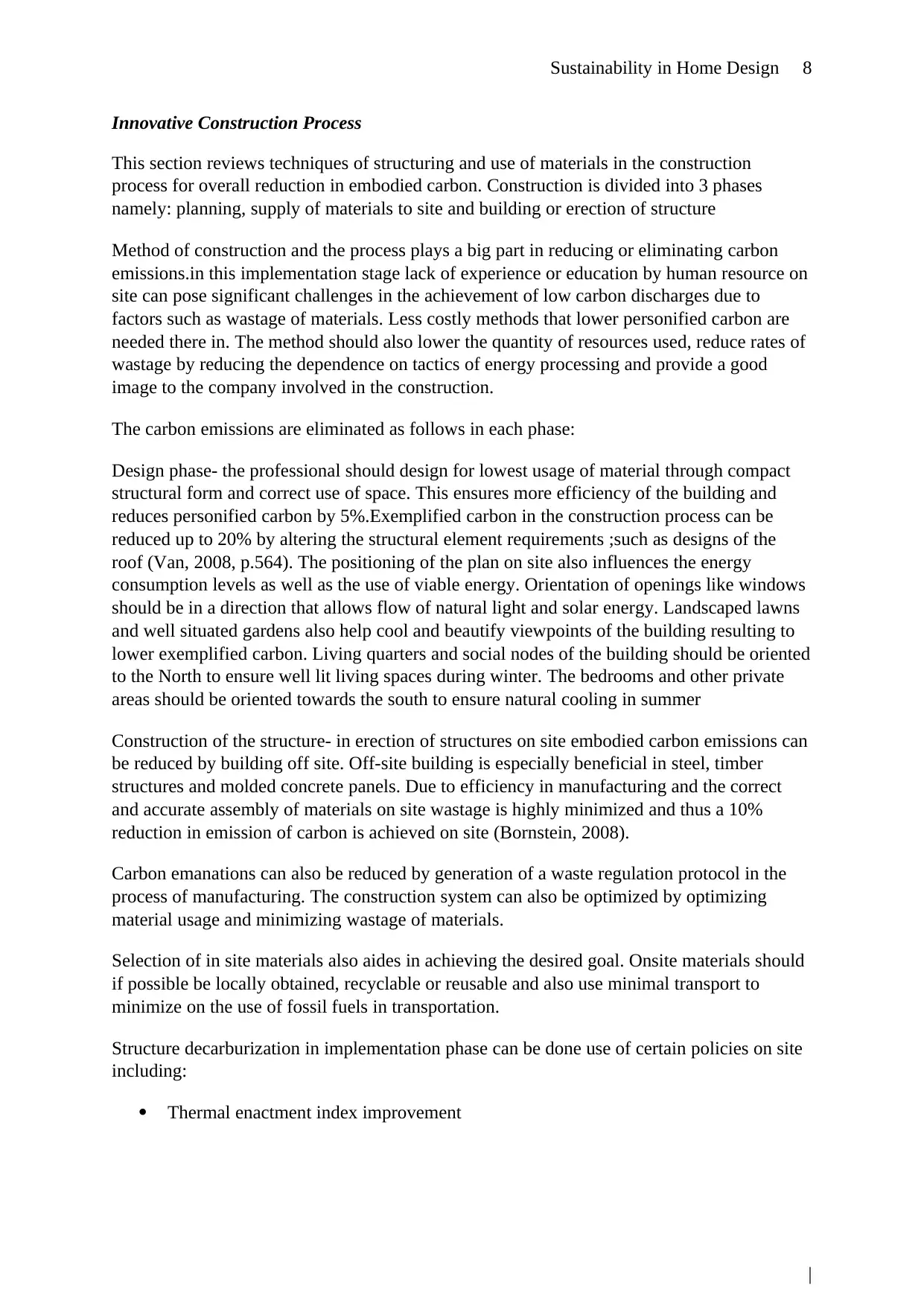
Sustainability in Home Design 8
Innovative Construction Process
This section reviews techniques of structuring and use of materials in the construction
process for overall reduction in embodied carbon. Construction is divided into 3 phases
namely: planning, supply of materials to site and building or erection of structure
Method of construction and the process plays a big part in reducing or eliminating carbon
emissions.in this implementation stage lack of experience or education by human resource on
site can pose significant challenges in the achievement of low carbon discharges due to
factors such as wastage of materials. Less costly methods that lower personified carbon are
needed there in. The method should also lower the quantity of resources used, reduce rates of
wastage by reducing the dependence on tactics of energy processing and provide a good
image to the company involved in the construction.
The carbon emissions are eliminated as follows in each phase:
Design phase- the professional should design for lowest usage of material through compact
structural form and correct use of space. This ensures more efficiency of the building and
reduces personified carbon by 5%.Exemplified carbon in the construction process can be
reduced up to 20% by altering the structural element requirements ;such as designs of the
roof (Van, 2008, p.564). The positioning of the plan on site also influences the energy
consumption levels as well as the use of viable energy. Orientation of openings like windows
should be in a direction that allows flow of natural light and solar energy. Landscaped lawns
and well situated gardens also help cool and beautify viewpoints of the building resulting to
lower exemplified carbon. Living quarters and social nodes of the building should be oriented
to the North to ensure well lit living spaces during winter. The bedrooms and other private
areas should be oriented towards the south to ensure natural cooling in summer
Construction of the structure- in erection of structures on site embodied carbon emissions can
be reduced by building off site. Off-site building is especially beneficial in steel, timber
structures and molded concrete panels. Due to efficiency in manufacturing and the correct
and accurate assembly of materials on site wastage is highly minimized and thus a 10%
reduction in emission of carbon is achieved on site (Bornstein, 2008).
Carbon emanations can also be reduced by generation of a waste regulation protocol in the
process of manufacturing. The construction system can also be optimized by optimizing
material usage and minimizing wastage of materials.
Selection of in site materials also aides in achieving the desired goal. Onsite materials should
if possible be locally obtained, recyclable or reusable and also use minimal transport to
minimize on the use of fossil fuels in transportation.
Structure decarburization in implementation phase can be done use of certain policies on site
including:
Thermal enactment index improvement
|
Innovative Construction Process
This section reviews techniques of structuring and use of materials in the construction
process for overall reduction in embodied carbon. Construction is divided into 3 phases
namely: planning, supply of materials to site and building or erection of structure
Method of construction and the process plays a big part in reducing or eliminating carbon
emissions.in this implementation stage lack of experience or education by human resource on
site can pose significant challenges in the achievement of low carbon discharges due to
factors such as wastage of materials. Less costly methods that lower personified carbon are
needed there in. The method should also lower the quantity of resources used, reduce rates of
wastage by reducing the dependence on tactics of energy processing and provide a good
image to the company involved in the construction.
The carbon emissions are eliminated as follows in each phase:
Design phase- the professional should design for lowest usage of material through compact
structural form and correct use of space. This ensures more efficiency of the building and
reduces personified carbon by 5%.Exemplified carbon in the construction process can be
reduced up to 20% by altering the structural element requirements ;such as designs of the
roof (Van, 2008, p.564). The positioning of the plan on site also influences the energy
consumption levels as well as the use of viable energy. Orientation of openings like windows
should be in a direction that allows flow of natural light and solar energy. Landscaped lawns
and well situated gardens also help cool and beautify viewpoints of the building resulting to
lower exemplified carbon. Living quarters and social nodes of the building should be oriented
to the North to ensure well lit living spaces during winter. The bedrooms and other private
areas should be oriented towards the south to ensure natural cooling in summer
Construction of the structure- in erection of structures on site embodied carbon emissions can
be reduced by building off site. Off-site building is especially beneficial in steel, timber
structures and molded concrete panels. Due to efficiency in manufacturing and the correct
and accurate assembly of materials on site wastage is highly minimized and thus a 10%
reduction in emission of carbon is achieved on site (Bornstein, 2008).
Carbon emanations can also be reduced by generation of a waste regulation protocol in the
process of manufacturing. The construction system can also be optimized by optimizing
material usage and minimizing wastage of materials.
Selection of in site materials also aides in achieving the desired goal. Onsite materials should
if possible be locally obtained, recyclable or reusable and also use minimal transport to
minimize on the use of fossil fuels in transportation.
Structure decarburization in implementation phase can be done use of certain policies on site
including:
Thermal enactment index improvement
|
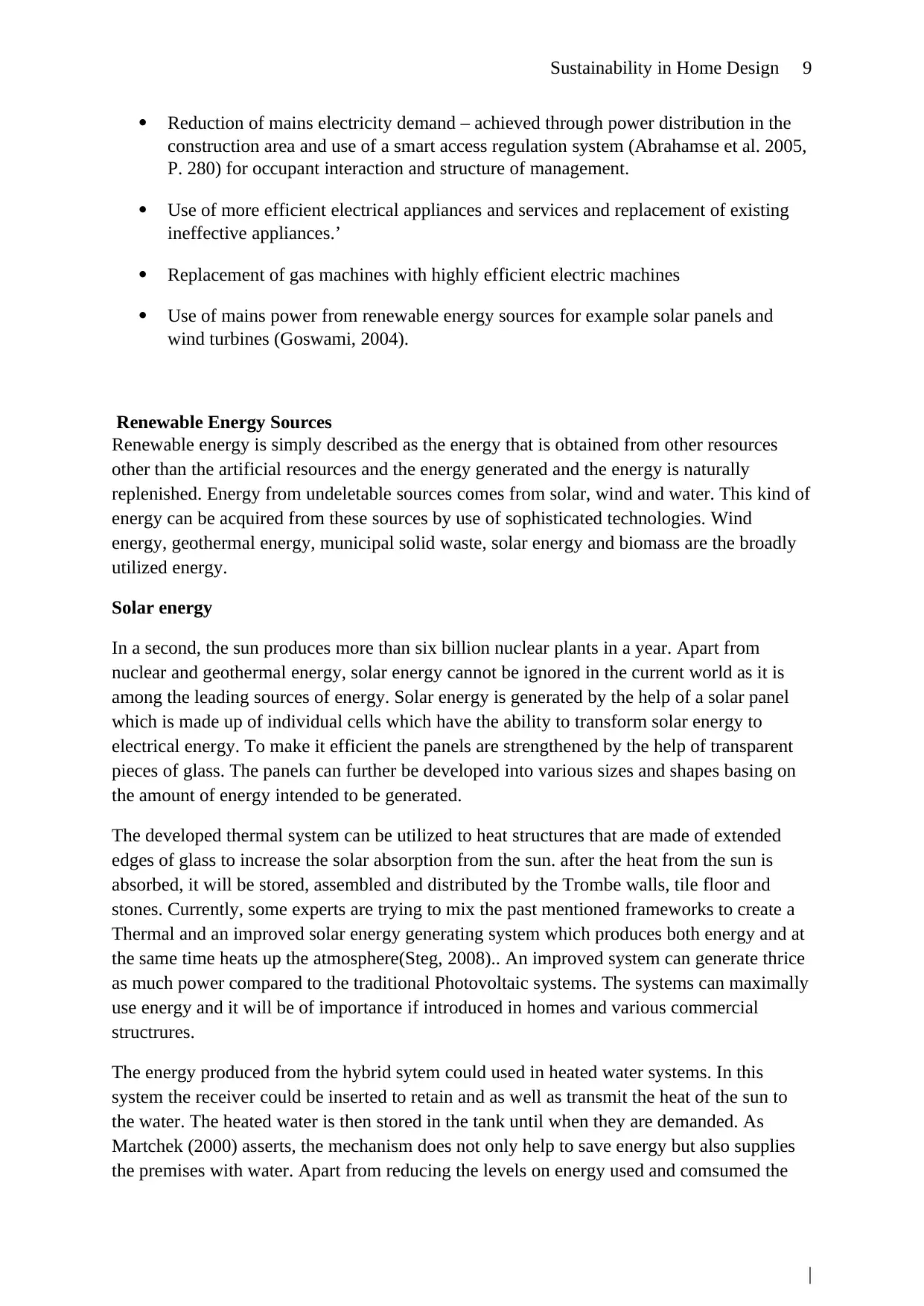
Sustainability in Home Design 9
Reduction of mains electricity demand – achieved through power distribution in the
construction area and use of a smart access regulation system (Abrahamse et al. 2005,
P. 280) for occupant interaction and structure of management.
Use of more efficient electrical appliances and services and replacement of existing
ineffective appliances.’
Replacement of gas machines with highly efficient electric machines
Use of mains power from renewable energy sources for example solar panels and
wind turbines (Goswami, 2004).
Renewable Energy Sources
Renewable energy is simply described as the energy that is obtained from other resources
other than the artificial resources and the energy generated and the energy is naturally
replenished. Energy from undeletable sources comes from solar, wind and water. This kind of
energy can be acquired from these sources by use of sophisticated technologies. Wind
energy, geothermal energy, municipal solid waste, solar energy and biomass are the broadly
utilized energy.
Solar energy
In a second, the sun produces more than six billion nuclear plants in a year. Apart from
nuclear and geothermal energy, solar energy cannot be ignored in the current world as it is
among the leading sources of energy. Solar energy is generated by the help of a solar panel
which is made up of individual cells which have the ability to transform solar energy to
electrical energy. To make it efficient the panels are strengthened by the help of transparent
pieces of glass. The panels can further be developed into various sizes and shapes basing on
the amount of energy intended to be generated.
The developed thermal system can be utilized to heat structures that are made of extended
edges of glass to increase the solar absorption from the sun. after the heat from the sun is
absorbed, it will be stored, assembled and distributed by the Trombe walls, tile floor and
stones. Currently, some experts are trying to mix the past mentioned frameworks to create a
Thermal and an improved solar energy generating system which produces both energy and at
the same time heats up the atmosphere(Steg, 2008).. An improved system can generate thrice
as much power compared to the traditional Photovoltaic systems. The systems can maximally
use energy and it will be of importance if introduced in homes and various commercial
structrures.
The energy produced from the hybrid sytem could used in heated water systems. In this
system the receiver could be inserted to retain and as well as transmit the heat of the sun to
the water. The heated water is then stored in the tank until when they are demanded. As
Martchek (2000) asserts, the mechanism does not only help to save energy but also supplies
the premises with water. Apart from reducing the levels on energy used and comsumed the
|
Reduction of mains electricity demand – achieved through power distribution in the
construction area and use of a smart access regulation system (Abrahamse et al. 2005,
P. 280) for occupant interaction and structure of management.
Use of more efficient electrical appliances and services and replacement of existing
ineffective appliances.’
Replacement of gas machines with highly efficient electric machines
Use of mains power from renewable energy sources for example solar panels and
wind turbines (Goswami, 2004).
Renewable Energy Sources
Renewable energy is simply described as the energy that is obtained from other resources
other than the artificial resources and the energy generated and the energy is naturally
replenished. Energy from undeletable sources comes from solar, wind and water. This kind of
energy can be acquired from these sources by use of sophisticated technologies. Wind
energy, geothermal energy, municipal solid waste, solar energy and biomass are the broadly
utilized energy.
Solar energy
In a second, the sun produces more than six billion nuclear plants in a year. Apart from
nuclear and geothermal energy, solar energy cannot be ignored in the current world as it is
among the leading sources of energy. Solar energy is generated by the help of a solar panel
which is made up of individual cells which have the ability to transform solar energy to
electrical energy. To make it efficient the panels are strengthened by the help of transparent
pieces of glass. The panels can further be developed into various sizes and shapes basing on
the amount of energy intended to be generated.
The developed thermal system can be utilized to heat structures that are made of extended
edges of glass to increase the solar absorption from the sun. after the heat from the sun is
absorbed, it will be stored, assembled and distributed by the Trombe walls, tile floor and
stones. Currently, some experts are trying to mix the past mentioned frameworks to create a
Thermal and an improved solar energy generating system which produces both energy and at
the same time heats up the atmosphere(Steg, 2008).. An improved system can generate thrice
as much power compared to the traditional Photovoltaic systems. The systems can maximally
use energy and it will be of importance if introduced in homes and various commercial
structrures.
The energy produced from the hybrid sytem could used in heated water systems. In this
system the receiver could be inserted to retain and as well as transmit the heat of the sun to
the water. The heated water is then stored in the tank until when they are demanded. As
Martchek (2000) asserts, the mechanism does not only help to save energy but also supplies
the premises with water. Apart from reducing the levels on energy used and comsumed the
|
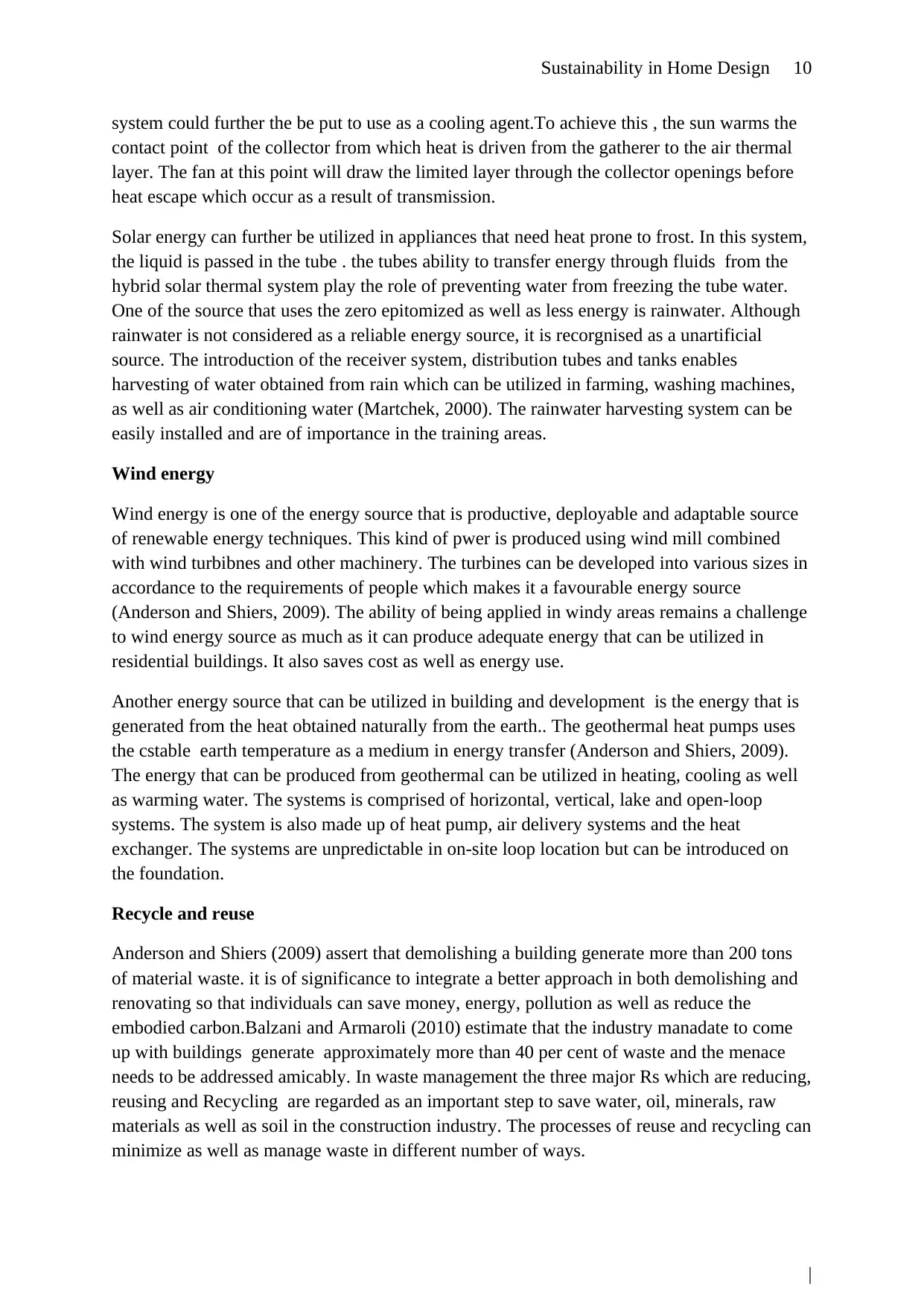
Sustainability in Home Design 10
system could further the be put to use as a cooling agent.To achieve this , the sun warms the
contact point of the collector from which heat is driven from the gatherer to the air thermal
layer. The fan at this point will draw the limited layer through the collector openings before
heat escape which occur as a result of transmission.
Solar energy can further be utilized in appliances that need heat prone to frost. In this system,
the liquid is passed in the tube . the tubes ability to transfer energy through fluids from the
hybrid solar thermal system play the role of preventing water from freezing the tube water.
One of the source that uses the zero epitomized as well as less energy is rainwater. Although
rainwater is not considered as a reliable energy source, it is recorgnised as a unartificial
source. The introduction of the receiver system, distribution tubes and tanks enables
harvesting of water obtained from rain which can be utilized in farming, washing machines,
as well as air conditioning water (Martchek, 2000). The rainwater harvesting system can be
easily installed and are of importance in the training areas.
Wind energy
Wind energy is one of the energy source that is productive, deployable and adaptable source
of renewable energy techniques. This kind of pwer is produced using wind mill combined
with wind turbibnes and other machinery. The turbines can be developed into various sizes in
accordance to the requirements of people which makes it a favourable energy source
(Anderson and Shiers, 2009). The ability of being applied in windy areas remains a challenge
to wind energy source as much as it can produce adequate energy that can be utilized in
residential buildings. It also saves cost as well as energy use.
Another energy source that can be utilized in building and development is the energy that is
generated from the heat obtained naturally from the earth.. The geothermal heat pumps uses
the cstable earth temperature as a medium in energy transfer (Anderson and Shiers, 2009).
The energy that can be produced from geothermal can be utilized in heating, cooling as well
as warming water. The systems is comprised of horizontal, vertical, lake and open-loop
systems. The system is also made up of heat pump, air delivery systems and the heat
exchanger. The systems are unpredictable in on-site loop location but can be introduced on
the foundation.
Recycle and reuse
Anderson and Shiers (2009) assert that demolishing a building generate more than 200 tons
of material waste. it is of significance to integrate a better approach in both demolishing and
renovating so that individuals can save money, energy, pollution as well as reduce the
embodied carbon.Balzani and Armaroli (2010) estimate that the industry manadate to come
up with buildings generate approximately more than 40 per cent of waste and the menace
needs to be addressed amicably. In waste management the three major Rs which are reducing,
reusing and Recycling are regarded as an important step to save water, oil, minerals, raw
materials as well as soil in the construction industry. The processes of reuse and recycling can
minimize as well as manage waste in different number of ways.
|
system could further the be put to use as a cooling agent.To achieve this , the sun warms the
contact point of the collector from which heat is driven from the gatherer to the air thermal
layer. The fan at this point will draw the limited layer through the collector openings before
heat escape which occur as a result of transmission.
Solar energy can further be utilized in appliances that need heat prone to frost. In this system,
the liquid is passed in the tube . the tubes ability to transfer energy through fluids from the
hybrid solar thermal system play the role of preventing water from freezing the tube water.
One of the source that uses the zero epitomized as well as less energy is rainwater. Although
rainwater is not considered as a reliable energy source, it is recorgnised as a unartificial
source. The introduction of the receiver system, distribution tubes and tanks enables
harvesting of water obtained from rain which can be utilized in farming, washing machines,
as well as air conditioning water (Martchek, 2000). The rainwater harvesting system can be
easily installed and are of importance in the training areas.
Wind energy
Wind energy is one of the energy source that is productive, deployable and adaptable source
of renewable energy techniques. This kind of pwer is produced using wind mill combined
with wind turbibnes and other machinery. The turbines can be developed into various sizes in
accordance to the requirements of people which makes it a favourable energy source
(Anderson and Shiers, 2009). The ability of being applied in windy areas remains a challenge
to wind energy source as much as it can produce adequate energy that can be utilized in
residential buildings. It also saves cost as well as energy use.
Another energy source that can be utilized in building and development is the energy that is
generated from the heat obtained naturally from the earth.. The geothermal heat pumps uses
the cstable earth temperature as a medium in energy transfer (Anderson and Shiers, 2009).
The energy that can be produced from geothermal can be utilized in heating, cooling as well
as warming water. The systems is comprised of horizontal, vertical, lake and open-loop
systems. The system is also made up of heat pump, air delivery systems and the heat
exchanger. The systems are unpredictable in on-site loop location but can be introduced on
the foundation.
Recycle and reuse
Anderson and Shiers (2009) assert that demolishing a building generate more than 200 tons
of material waste. it is of significance to integrate a better approach in both demolishing and
renovating so that individuals can save money, energy, pollution as well as reduce the
embodied carbon.Balzani and Armaroli (2010) estimate that the industry manadate to come
up with buildings generate approximately more than 40 per cent of waste and the menace
needs to be addressed amicably. In waste management the three major Rs which are reducing,
reusing and Recycling are regarded as an important step to save water, oil, minerals, raw
materials as well as soil in the construction industry. The processes of reuse and recycling can
minimize as well as manage waste in different number of ways.
|
Secure Best Marks with AI Grader
Need help grading? Try our AI Grader for instant feedback on your assignments.

Sustainability in Home Design 11
First and foremost, one of the ways of managing waste is avoiding. Avoiding makes people
to isolate hard waste in a way that counteracts the loss that is produced by wind and water.
This kind of waste management is important for concrete and sand which are precious
materials in the construction industry (Balzani and Armaroli, 2010). Pre-assembled parts
utilization is another way of avoiding waste. additionally, discarding litter in a secure area or
three-sided litter equipment to minize littering is also one of the method of keeping a distance
from waste.
Group wet weather areas together to reduce plumbing materials number is one of the
approaches that can be utilized to minimize waste developments. The requirement for major
attractions ought to be minimized in future through introducing some designs that allow
changes in the way utilized in homes. Long lasting materials such as steel and bricks ought to
be used to reduce material repairs and replacements for more than 50 years.
The most successful method that have been used in managing waste is reuse. Building, boxes,
beds and system reuse save energy as well as cost. A strategic location can be selected to cut
as well as store off-cuts making short materials useful. The building completely utilizes
reuse of materials when it is demolished in the reverse order of construction. Besides, wastes
and materials recycling through reuse is imperative in keeping up sustainability. In
construction, this can be attained by remodelling the waste products to come up with new
ones that could be utilized in other means. The weatherboards, frames and timber from floors
as well as skirting board can be utilized in making furniture (Khan et al. 2004. P.23). The
carpets in a better form can also be reused. This can be achieved when they can be
remodelled to create aonother carpet is made from materials that were initially not part of the
original product. Utilization of every peace that is considered as left over the construction
process is essential for instance collection of and concrete after the whole process and
separating them will lead to reusing of the same and thus aving on the cost of acquring new
raw material.. According to Balzani and Armaroli (2010), aluminium is another useful
material that need to be recycled. This is because it can be recycled without value loss and 5
per cent of energy is needed to make new aluminium.
Apart from aluminium, aluminium is another useful material in the construction industry and
it is regarded as one of the materials that could easily be remodelled in the world. Facades,
structural applications and divider cladding can be recycled fully to form other products. On
the other hand, the glasses used in construction are also important but they ought to be
isolated from the different glass types. They should be recycled by cutting them and using
them for the purposes meant for concrete aggregates. Plasterboards made from gypsum
should be remodelled or treated since they generate harmful hydrogen sulfide that smells
badly and could be harmful to human beings.(Borenstein, 2008). In this respect, plastics can
also be recycled through the process of granulating or changed into new plastic items. plastics
can also be reused because when allowed in the environment, they tend to harm the
ecosystem. The tiles and blocks can be prevented from damage to be reused later. Crushed
tiles and blocks can be used as aggregates, backfill and gravel. Dixit et al. (2010) stipulates
that treat should be maximumly used when building. The waste products should be separated
in several litter traps to reduce recycling and tipping fee. As much as reuse and recycling is
|
First and foremost, one of the ways of managing waste is avoiding. Avoiding makes people
to isolate hard waste in a way that counteracts the loss that is produced by wind and water.
This kind of waste management is important for concrete and sand which are precious
materials in the construction industry (Balzani and Armaroli, 2010). Pre-assembled parts
utilization is another way of avoiding waste. additionally, discarding litter in a secure area or
three-sided litter equipment to minize littering is also one of the method of keeping a distance
from waste.
Group wet weather areas together to reduce plumbing materials number is one of the
approaches that can be utilized to minimize waste developments. The requirement for major
attractions ought to be minimized in future through introducing some designs that allow
changes in the way utilized in homes. Long lasting materials such as steel and bricks ought to
be used to reduce material repairs and replacements for more than 50 years.
The most successful method that have been used in managing waste is reuse. Building, boxes,
beds and system reuse save energy as well as cost. A strategic location can be selected to cut
as well as store off-cuts making short materials useful. The building completely utilizes
reuse of materials when it is demolished in the reverse order of construction. Besides, wastes
and materials recycling through reuse is imperative in keeping up sustainability. In
construction, this can be attained by remodelling the waste products to come up with new
ones that could be utilized in other means. The weatherboards, frames and timber from floors
as well as skirting board can be utilized in making furniture (Khan et al. 2004. P.23). The
carpets in a better form can also be reused. This can be achieved when they can be
remodelled to create aonother carpet is made from materials that were initially not part of the
original product. Utilization of every peace that is considered as left over the construction
process is essential for instance collection of and concrete after the whole process and
separating them will lead to reusing of the same and thus aving on the cost of acquring new
raw material.. According to Balzani and Armaroli (2010), aluminium is another useful
material that need to be recycled. This is because it can be recycled without value loss and 5
per cent of energy is needed to make new aluminium.
Apart from aluminium, aluminium is another useful material in the construction industry and
it is regarded as one of the materials that could easily be remodelled in the world. Facades,
structural applications and divider cladding can be recycled fully to form other products. On
the other hand, the glasses used in construction are also important but they ought to be
isolated from the different glass types. They should be recycled by cutting them and using
them for the purposes meant for concrete aggregates. Plasterboards made from gypsum
should be remodelled or treated since they generate harmful hydrogen sulfide that smells
badly and could be harmful to human beings.(Borenstein, 2008). In this respect, plastics can
also be recycled through the process of granulating or changed into new plastic items. plastics
can also be reused because when allowed in the environment, they tend to harm the
ecosystem. The tiles and blocks can be prevented from damage to be reused later. Crushed
tiles and blocks can be used as aggregates, backfill and gravel. Dixit et al. (2010) stipulates
that treat should be maximumly used when building. The waste products should be separated
in several litter traps to reduce recycling and tipping fee. As much as reuse and recycling is
|
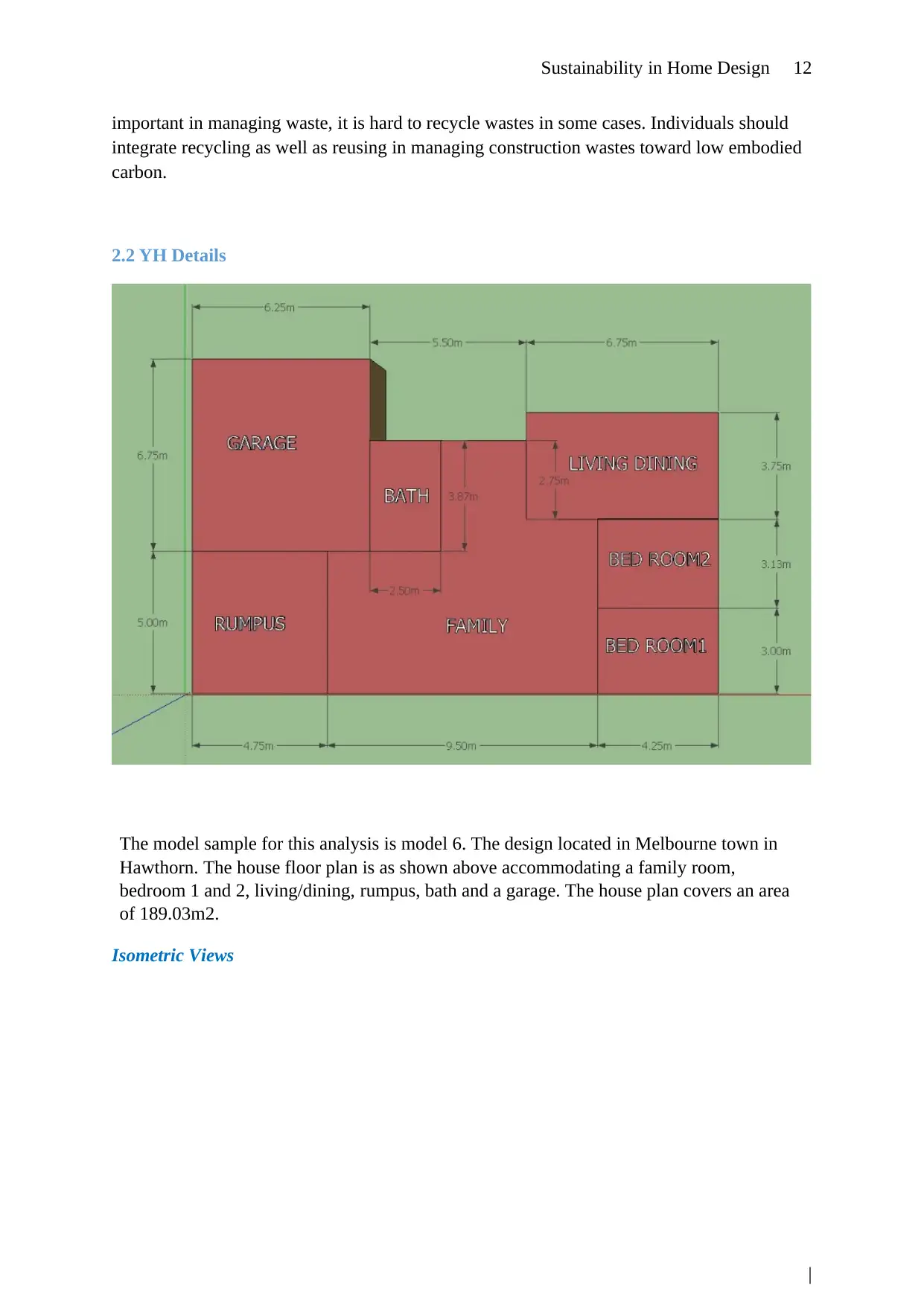
Sustainability in Home Design 12
important in managing waste, it is hard to recycle wastes in some cases. Individuals should
integrate recycling as well as reusing in managing construction wastes toward low embodied
carbon.
2.2 YH Details
The model sample for this analysis is model 6. The design located in Melbourne town in
Hawthorn. The house floor plan is as shown above accommodating a family room,
bedroom 1 and 2, living/dining, rumpus, bath and a garage. The house plan covers an area
of 189.03m2.
Isometric Views
|
important in managing waste, it is hard to recycle wastes in some cases. Individuals should
integrate recycling as well as reusing in managing construction wastes toward low embodied
carbon.
2.2 YH Details
The model sample for this analysis is model 6. The design located in Melbourne town in
Hawthorn. The house floor plan is as shown above accommodating a family room,
bedroom 1 and 2, living/dining, rumpus, bath and a garage. The house plan covers an area
of 189.03m2.
Isometric Views
|
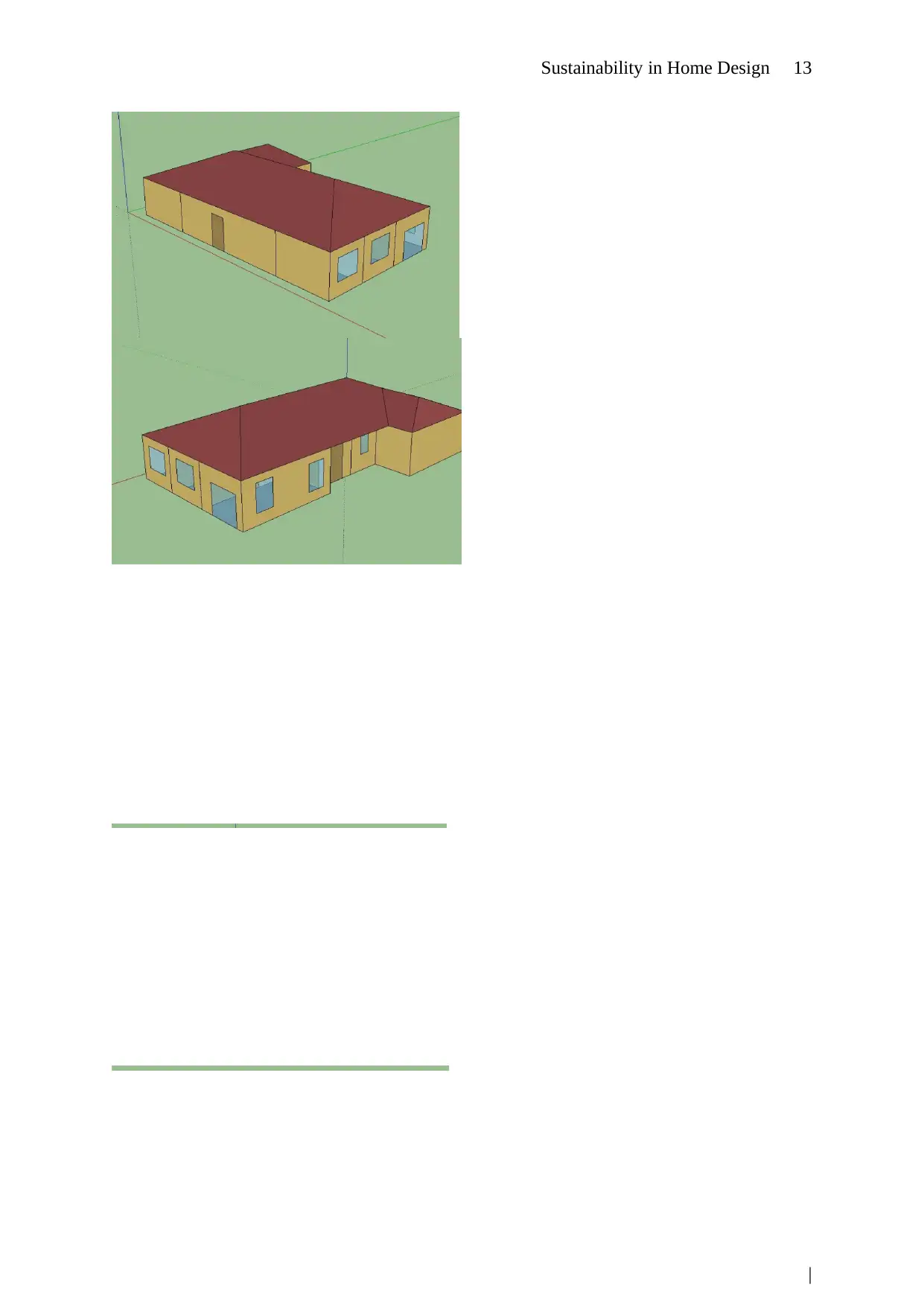
Sustainability in Home Design 13
|
|
Paraphrase This Document
Need a fresh take? Get an instant paraphrase of this document with our AI Paraphraser
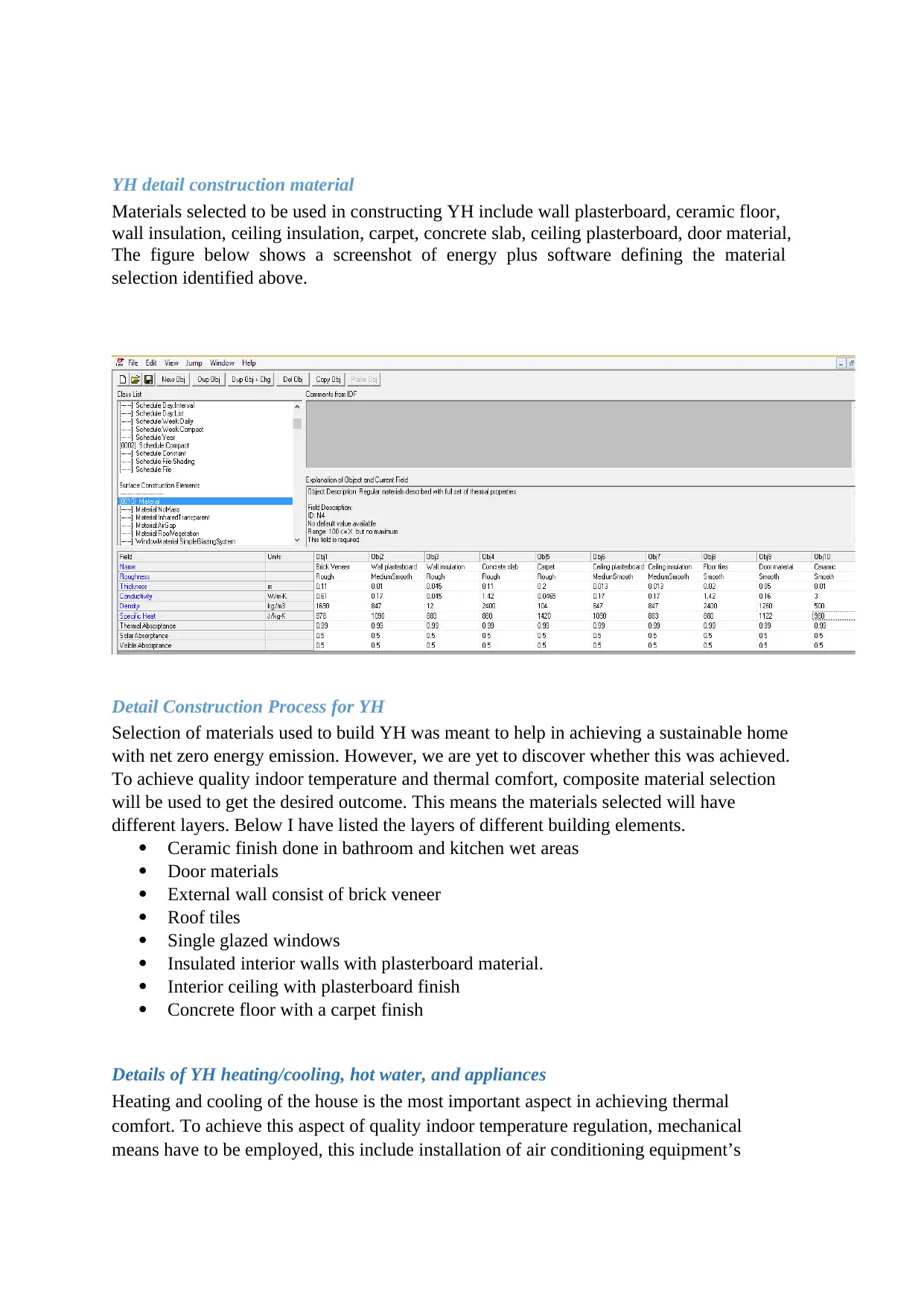
YH detail construction material
Materials selected to be used in constructing YH include wall plasterboard, ceramic floor,
wall insulation, ceiling insulation, carpet, concrete slab, ceiling plasterboard, door material,
The figure below shows a screenshot of energy plus software defining the material
selection identified above.
Detail Construction Process for YH
Selection of materials used to build YH was meant to help in achieving a sustainable home
with net zero energy emission. However, we are yet to discover whether this was achieved.
To achieve quality indoor temperature and thermal comfort, composite material selection
will be used to get the desired outcome. This means the materials selected will have
different layers. Below I have listed the layers of different building elements.
Ceramic finish done in bathroom and kitchen wet areas
Door materials
External wall consist of brick veneer
Roof tiles
Single glazed windows
Insulated interior walls with plasterboard material.
Interior ceiling with plasterboard finish
Concrete floor with a carpet finish
Details of YH heating/cooling, hot water, and appliances
Heating and cooling of the house is the most important aspect in achieving thermal
comfort. To achieve this aspect of quality indoor temperature regulation, mechanical
means have to be employed, this include installation of air conditioning equipment’s
Materials selected to be used in constructing YH include wall plasterboard, ceramic floor,
wall insulation, ceiling insulation, carpet, concrete slab, ceiling plasterboard, door material,
The figure below shows a screenshot of energy plus software defining the material
selection identified above.
Detail Construction Process for YH
Selection of materials used to build YH was meant to help in achieving a sustainable home
with net zero energy emission. However, we are yet to discover whether this was achieved.
To achieve quality indoor temperature and thermal comfort, composite material selection
will be used to get the desired outcome. This means the materials selected will have
different layers. Below I have listed the layers of different building elements.
Ceramic finish done in bathroom and kitchen wet areas
Door materials
External wall consist of brick veneer
Roof tiles
Single glazed windows
Insulated interior walls with plasterboard material.
Interior ceiling with plasterboard finish
Concrete floor with a carpet finish
Details of YH heating/cooling, hot water, and appliances
Heating and cooling of the house is the most important aspect in achieving thermal
comfort. To achieve this aspect of quality indoor temperature regulation, mechanical
means have to be employed, this include installation of air conditioning equipment’s
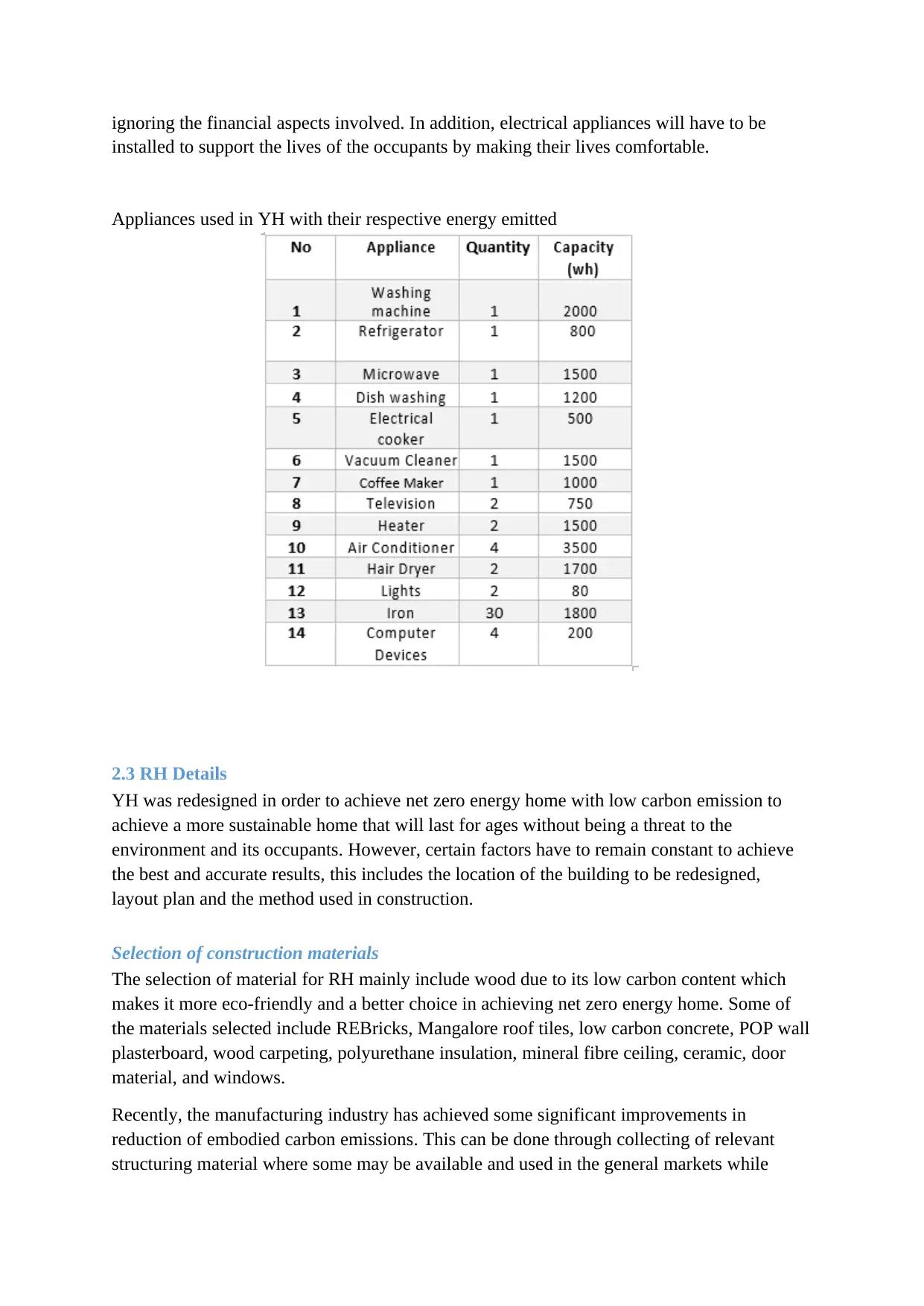
ignoring the financial aspects involved. In addition, electrical appliances will have to be
installed to support the lives of the occupants by making their lives comfortable.
Appliances used in YH with their respective energy emitted
2.3 RH Details
YH was redesigned in order to achieve net zero energy home with low carbon emission to
achieve a more sustainable home that will last for ages without being a threat to the
environment and its occupants. However, certain factors have to remain constant to achieve
the best and accurate results, this includes the location of the building to be redesigned,
layout plan and the method used in construction.
Selection of construction materials
The selection of material for RH mainly include wood due to its low carbon content which
makes it more eco-friendly and a better choice in achieving net zero energy home. Some of
the materials selected include REBricks, Mangalore roof tiles, low carbon concrete, POP wall
plasterboard, wood carpeting, polyurethane insulation, mineral fibre ceiling, ceramic, door
material, and windows.
Recently, the manufacturing industry has achieved some significant improvements in
reduction of embodied carbon emissions. This can be done through collecting of relevant
structuring material where some may be available and used in the general markets while
installed to support the lives of the occupants by making their lives comfortable.
Appliances used in YH with their respective energy emitted
2.3 RH Details
YH was redesigned in order to achieve net zero energy home with low carbon emission to
achieve a more sustainable home that will last for ages without being a threat to the
environment and its occupants. However, certain factors have to remain constant to achieve
the best and accurate results, this includes the location of the building to be redesigned,
layout plan and the method used in construction.
Selection of construction materials
The selection of material for RH mainly include wood due to its low carbon content which
makes it more eco-friendly and a better choice in achieving net zero energy home. Some of
the materials selected include REBricks, Mangalore roof tiles, low carbon concrete, POP wall
plasterboard, wood carpeting, polyurethane insulation, mineral fibre ceiling, ceramic, door
material, and windows.
Recently, the manufacturing industry has achieved some significant improvements in
reduction of embodied carbon emissions. This can be done through collecting of relevant
structuring material where some may be available and used in the general markets while
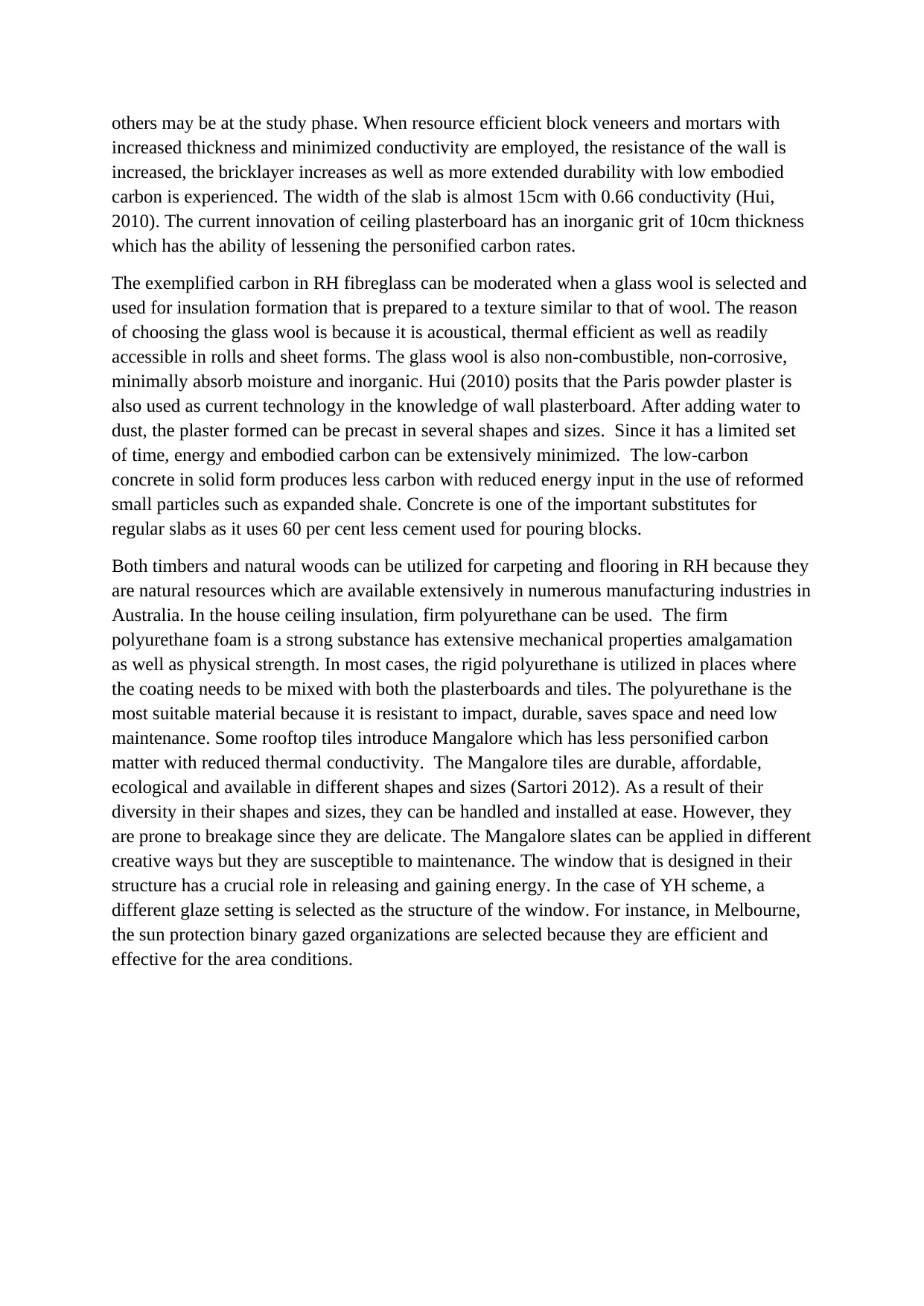
others may be at the study phase. When resource efficient block veneers and mortars with
increased thickness and minimized conductivity are employed, the resistance of the wall is
increased, the bricklayer increases as well as more extended durability with low embodied
carbon is experienced. The width of the slab is almost 15cm with 0.66 conductivity (Hui,
2010). The current innovation of ceiling plasterboard has an inorganic grit of 10cm thickness
which has the ability of lessening the personified carbon rates.
The exemplified carbon in RH fibreglass can be moderated when a glass wool is selected and
used for insulation formation that is prepared to a texture similar to that of wool. The reason
of choosing the glass wool is because it is acoustical, thermal efficient as well as readily
accessible in rolls and sheet forms. The glass wool is also non-combustible, non-corrosive,
minimally absorb moisture and inorganic. Hui (2010) posits that the Paris powder plaster is
also used as current technology in the knowledge of wall plasterboard. After adding water to
dust, the plaster formed can be precast in several shapes and sizes. Since it has a limited set
of time, energy and embodied carbon can be extensively minimized. The low-carbon
concrete in solid form produces less carbon with reduced energy input in the use of reformed
small particles such as expanded shale. Concrete is one of the important substitutes for
regular slabs as it uses 60 per cent less cement used for pouring blocks.
Both timbers and natural woods can be utilized for carpeting and flooring in RH because they
are natural resources which are available extensively in numerous manufacturing industries in
Australia. In the house ceiling insulation, firm polyurethane can be used. The firm
polyurethane foam is a strong substance has extensive mechanical properties amalgamation
as well as physical strength. In most cases, the rigid polyurethane is utilized in places where
the coating needs to be mixed with both the plasterboards and tiles. The polyurethane is the
most suitable material because it is resistant to impact, durable, saves space and need low
maintenance. Some rooftop tiles introduce Mangalore which has less personified carbon
matter with reduced thermal conductivity. The Mangalore tiles are durable, affordable,
ecological and available in different shapes and sizes (Sartori 2012). As a result of their
diversity in their shapes and sizes, they can be handled and installed at ease. However, they
are prone to breakage since they are delicate. The Mangalore slates can be applied in different
creative ways but they are susceptible to maintenance. The window that is designed in their
structure has a crucial role in releasing and gaining energy. In the case of YH scheme, a
different glaze setting is selected as the structure of the window. For instance, in Melbourne,
the sun protection binary gazed organizations are selected because they are efficient and
effective for the area conditions.
increased thickness and minimized conductivity are employed, the resistance of the wall is
increased, the bricklayer increases as well as more extended durability with low embodied
carbon is experienced. The width of the slab is almost 15cm with 0.66 conductivity (Hui,
2010). The current innovation of ceiling plasterboard has an inorganic grit of 10cm thickness
which has the ability of lessening the personified carbon rates.
The exemplified carbon in RH fibreglass can be moderated when a glass wool is selected and
used for insulation formation that is prepared to a texture similar to that of wool. The reason
of choosing the glass wool is because it is acoustical, thermal efficient as well as readily
accessible in rolls and sheet forms. The glass wool is also non-combustible, non-corrosive,
minimally absorb moisture and inorganic. Hui (2010) posits that the Paris powder plaster is
also used as current technology in the knowledge of wall plasterboard. After adding water to
dust, the plaster formed can be precast in several shapes and sizes. Since it has a limited set
of time, energy and embodied carbon can be extensively minimized. The low-carbon
concrete in solid form produces less carbon with reduced energy input in the use of reformed
small particles such as expanded shale. Concrete is one of the important substitutes for
regular slabs as it uses 60 per cent less cement used for pouring blocks.
Both timbers and natural woods can be utilized for carpeting and flooring in RH because they
are natural resources which are available extensively in numerous manufacturing industries in
Australia. In the house ceiling insulation, firm polyurethane can be used. The firm
polyurethane foam is a strong substance has extensive mechanical properties amalgamation
as well as physical strength. In most cases, the rigid polyurethane is utilized in places where
the coating needs to be mixed with both the plasterboards and tiles. The polyurethane is the
most suitable material because it is resistant to impact, durable, saves space and need low
maintenance. Some rooftop tiles introduce Mangalore which has less personified carbon
matter with reduced thermal conductivity. The Mangalore tiles are durable, affordable,
ecological and available in different shapes and sizes (Sartori 2012). As a result of their
diversity in their shapes and sizes, they can be handled and installed at ease. However, they
are prone to breakage since they are delicate. The Mangalore slates can be applied in different
creative ways but they are susceptible to maintenance. The window that is designed in their
structure has a crucial role in releasing and gaining energy. In the case of YH scheme, a
different glaze setting is selected as the structure of the window. For instance, in Melbourne,
the sun protection binary gazed organizations are selected because they are efficient and
effective for the area conditions.
Secure Best Marks with AI Grader
Need help grading? Try our AI Grader for instant feedback on your assignments.
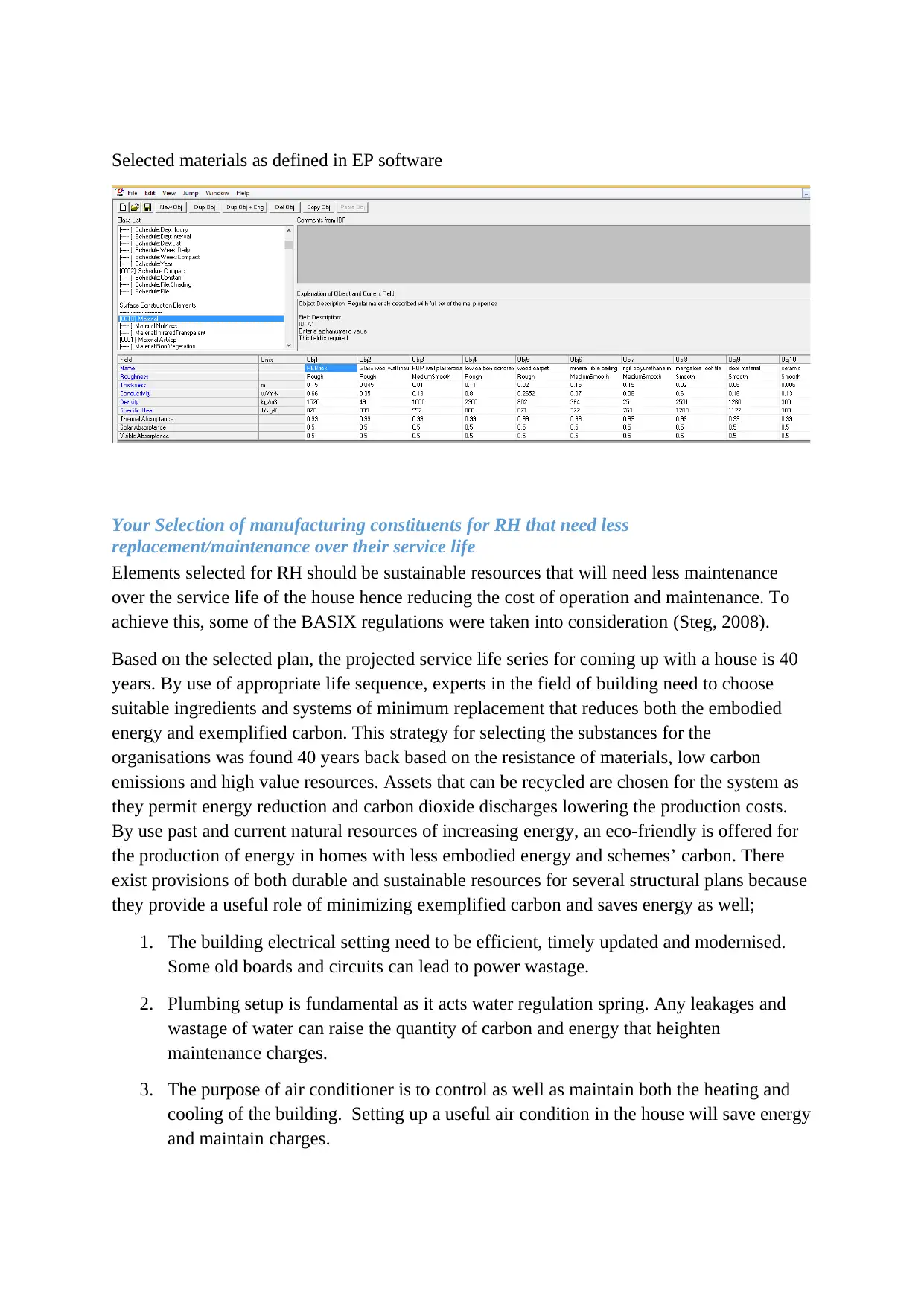
Selected materials as defined in EP software
Your Selection of manufacturing constituents for RH that need less
replacement/maintenance over their service life
Elements selected for RH should be sustainable resources that will need less maintenance
over the service life of the house hence reducing the cost of operation and maintenance. To
achieve this, some of the BASIX regulations were taken into consideration (Steg, 2008).
Based on the selected plan, the projected service life series for coming up with a house is 40
years. By use of appropriate life sequence, experts in the field of building need to choose
suitable ingredients and systems of minimum replacement that reduces both the embodied
energy and exemplified carbon. This strategy for selecting the substances for the
organisations was found 40 years back based on the resistance of materials, low carbon
emissions and high value resources. Assets that can be recycled are chosen for the system as
they permit energy reduction and carbon dioxide discharges lowering the production costs.
By use past and current natural resources of increasing energy, an eco-friendly is offered for
the production of energy in homes with less embodied energy and schemes’ carbon. There
exist provisions of both durable and sustainable resources for several structural plans because
they provide a useful role of minimizing exemplified carbon and saves energy as well;
1. The building electrical setting need to be efficient, timely updated and modernised.
Some old boards and circuits can lead to power wastage.
2. Plumbing setup is fundamental as it acts water regulation spring. Any leakages and
wastage of water can raise the quantity of carbon and energy that heighten
maintenance charges.
3. The purpose of air conditioner is to control as well as maintain both the heating and
cooling of the building. Setting up a useful air condition in the house will save energy
and maintain charges.
Your Selection of manufacturing constituents for RH that need less
replacement/maintenance over their service life
Elements selected for RH should be sustainable resources that will need less maintenance
over the service life of the house hence reducing the cost of operation and maintenance. To
achieve this, some of the BASIX regulations were taken into consideration (Steg, 2008).
Based on the selected plan, the projected service life series for coming up with a house is 40
years. By use of appropriate life sequence, experts in the field of building need to choose
suitable ingredients and systems of minimum replacement that reduces both the embodied
energy and exemplified carbon. This strategy for selecting the substances for the
organisations was found 40 years back based on the resistance of materials, low carbon
emissions and high value resources. Assets that can be recycled are chosen for the system as
they permit energy reduction and carbon dioxide discharges lowering the production costs.
By use past and current natural resources of increasing energy, an eco-friendly is offered for
the production of energy in homes with less embodied energy and schemes’ carbon. There
exist provisions of both durable and sustainable resources for several structural plans because
they provide a useful role of minimizing exemplified carbon and saves energy as well;
1. The building electrical setting need to be efficient, timely updated and modernised.
Some old boards and circuits can lead to power wastage.
2. Plumbing setup is fundamental as it acts water regulation spring. Any leakages and
wastage of water can raise the quantity of carbon and energy that heighten
maintenance charges.
3. The purpose of air conditioner is to control as well as maintain both the heating and
cooling of the building. Setting up a useful air condition in the house will save energy
and maintain charges.
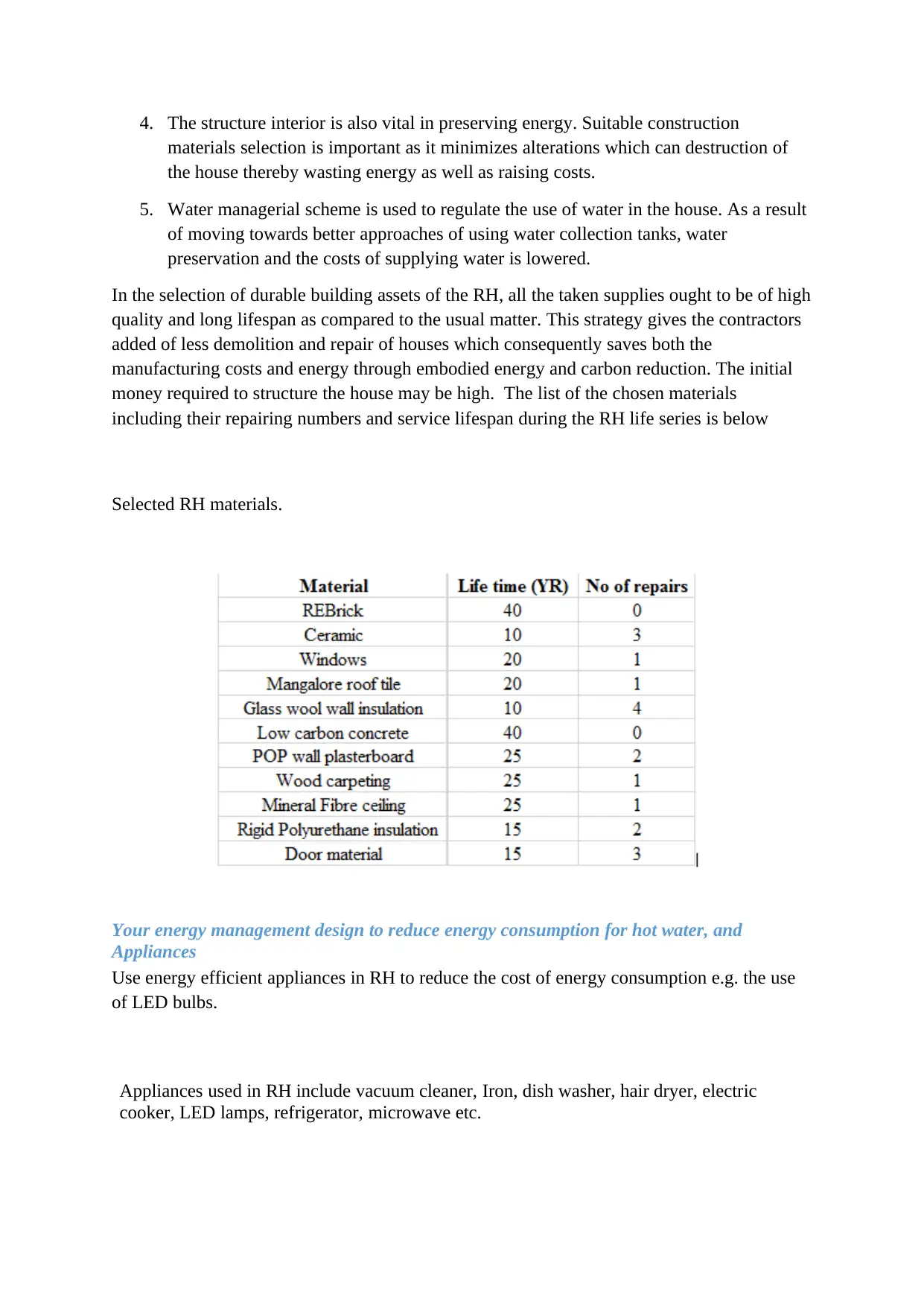
4. The structure interior is also vital in preserving energy. Suitable construction
materials selection is important as it minimizes alterations which can destruction of
the house thereby wasting energy as well as raising costs.
5. Water managerial scheme is used to regulate the use of water in the house. As a result
of moving towards better approaches of using water collection tanks, water
preservation and the costs of supplying water is lowered.
In the selection of durable building assets of the RH, all the taken supplies ought to be of high
quality and long lifespan as compared to the usual matter. This strategy gives the contractors
added of less demolition and repair of houses which consequently saves both the
manufacturing costs and energy through embodied energy and carbon reduction. The initial
money required to structure the house may be high. The list of the chosen materials
including their repairing numbers and service lifespan during the RH life series is below
Selected RH materials.
Your energy management design to reduce energy consumption for hot water, and
Appliances
Use energy efficient appliances in RH to reduce the cost of energy consumption e.g. the use
of LED bulbs.
Appliances used in RH include vacuum cleaner, Iron, dish washer, hair dryer, electric
cooker, LED lamps, refrigerator, microwave etc.
materials selection is important as it minimizes alterations which can destruction of
the house thereby wasting energy as well as raising costs.
5. Water managerial scheme is used to regulate the use of water in the house. As a result
of moving towards better approaches of using water collection tanks, water
preservation and the costs of supplying water is lowered.
In the selection of durable building assets of the RH, all the taken supplies ought to be of high
quality and long lifespan as compared to the usual matter. This strategy gives the contractors
added of less demolition and repair of houses which consequently saves both the
manufacturing costs and energy through embodied energy and carbon reduction. The initial
money required to structure the house may be high. The list of the chosen materials
including their repairing numbers and service lifespan during the RH life series is below
Selected RH materials.
Your energy management design to reduce energy consumption for hot water, and
Appliances
Use energy efficient appliances in RH to reduce the cost of energy consumption e.g. the use
of LED bulbs.
Appliances used in RH include vacuum cleaner, Iron, dish washer, hair dryer, electric
cooker, LED lamps, refrigerator, microwave etc.

Your selection of on-site renewable energy
2.4 Estimating the annual and total carbon emission over the service life of YH and RH
Estimation of embodied carbon emission of YH and RH Construction Material
Estimation of embodied carbon emission of the house will require a sum of embodied
carbon of all the elements constituting the house. The embodied carbon is obtained in kg
CO2. It is important to take note of the model floor area which is 189.03m2, with a wall
height of 3m, and a ceiling area of 189.03m2.
YH embodied carbon
2.4 Estimating the annual and total carbon emission over the service life of YH and RH
Estimation of embodied carbon emission of YH and RH Construction Material
Estimation of embodied carbon emission of the house will require a sum of embodied
carbon of all the elements constituting the house. The embodied carbon is obtained in kg
CO2. It is important to take note of the model floor area which is 189.03m2, with a wall
height of 3m, and a ceiling area of 189.03m2.
YH embodied carbon
Paraphrase This Document
Need a fresh take? Get an instant paraphrase of this document with our AI Paraphraser

Total embodied carbon for YH will be 103,470 KgCO2 for a life time of 40 years and
2,586.75 KgCO2 emitted per annum.
RH embodied carbon
Total embodied carbon for RH will be 57, 419KgCO2 for a life time of 40 years and
1435.48KgCO2 emitted per annum.
Estimation of carbon emission related to the construction of YH and RH
The embodied energy will be converted into embodied carbon.
The formula for conversion of MJ into KgCO2 is described as follows:
1 MJ= 0.098 KgCO2
Internal walls
= 906.5 MJ/m2*130 = 117910*0.098 = 11555.18KgCO2
Cavity brick wall
2,586.75 KgCO2 emitted per annum.
RH embodied carbon
Total embodied carbon for RH will be 57, 419KgCO2 for a life time of 40 years and
1435.48KgCO2 emitted per annum.
Estimation of carbon emission related to the construction of YH and RH
The embodied energy will be converted into embodied carbon.
The formula for conversion of MJ into KgCO2 is described as follows:
1 MJ= 0.098 KgCO2
Internal walls
= 906.5 MJ/m2*130 = 117910*0.098 = 11555.18KgCO2
Cavity brick wall
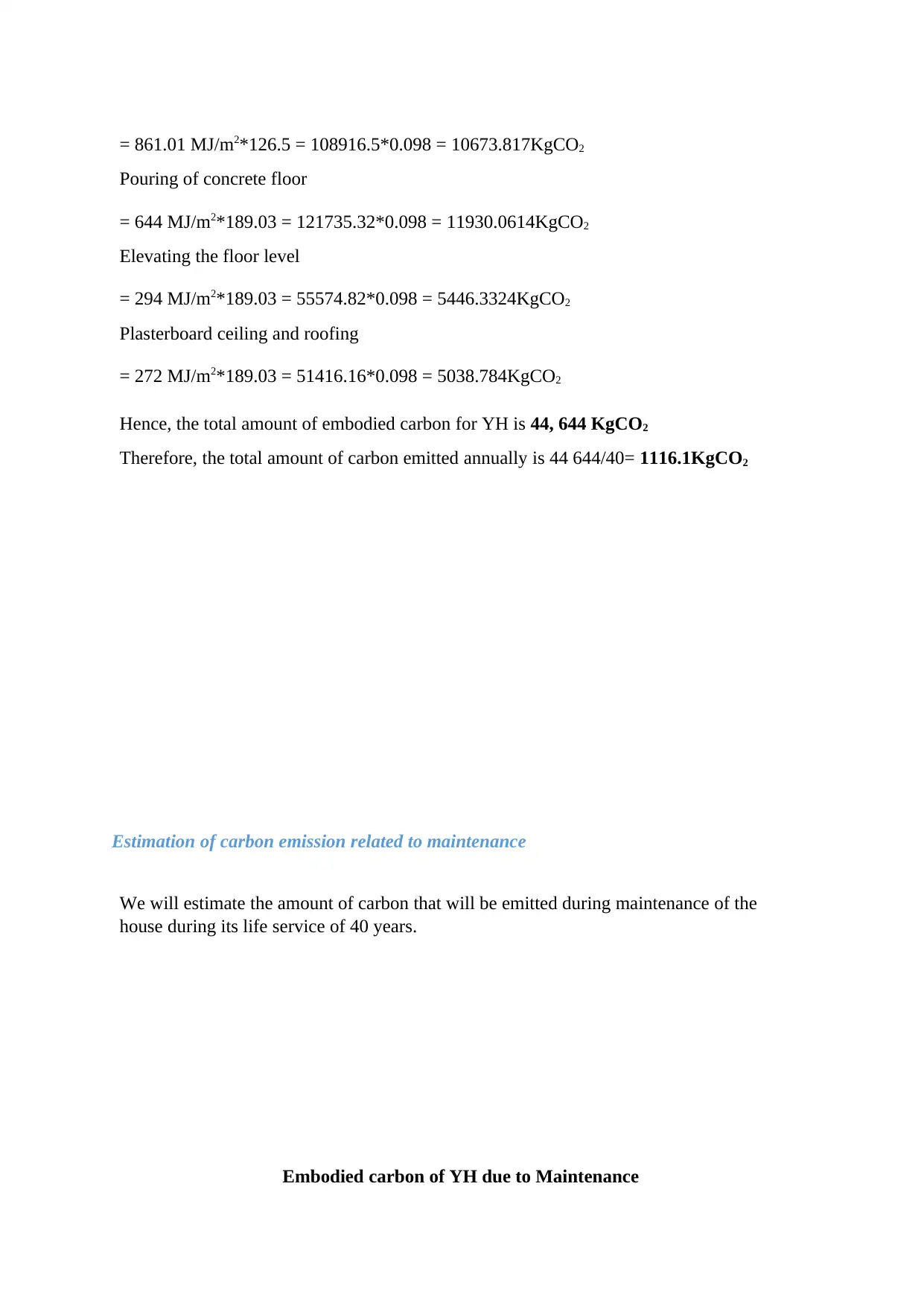
= 861.01 MJ/m2*126.5 = 108916.5*0.098 = 10673.817KgCO2
Pouring of concrete floor
= 644 MJ/m2*189.03 = 121735.32*0.098 = 11930.0614KgCO2
Elevating the floor level
= 294 MJ/m2*189.03 = 55574.82*0.098 = 5446.3324KgCO2
Plasterboard ceiling and roofing
= 272 MJ/m2*189.03 = 51416.16*0.098 = 5038.784KgCO2
Hence, the total amount of embodied carbon for YH is 44, 644 KgCO2
Therefore, the total amount of carbon emitted annually is 44 644/40= 1116.1KgCO2
Estimation of carbon emission related to maintenance
We will estimate the amount of carbon that will be emitted during maintenance of the
house during its life service of 40 years.
Embodied carbon of YH due to Maintenance
Pouring of concrete floor
= 644 MJ/m2*189.03 = 121735.32*0.098 = 11930.0614KgCO2
Elevating the floor level
= 294 MJ/m2*189.03 = 55574.82*0.098 = 5446.3324KgCO2
Plasterboard ceiling and roofing
= 272 MJ/m2*189.03 = 51416.16*0.098 = 5038.784KgCO2
Hence, the total amount of embodied carbon for YH is 44, 644 KgCO2
Therefore, the total amount of carbon emitted annually is 44 644/40= 1116.1KgCO2
Estimation of carbon emission related to maintenance
We will estimate the amount of carbon that will be emitted during maintenance of the
house during its life service of 40 years.
Embodied carbon of YH due to Maintenance

Carbon emission for a service life of 40 years will be 130,521.01 KgCO2 with an
annual emission of: 130 521/40= 3, 263.025.01 KgCO2.
Maintenance Embodied Carbon in RH
Carbon emission for a service life of 40 years of RH will be 45,021KgCO2 with an
annual emission of: 45,021/40= 1,125.525.03 KgCO2.
Estimation of carbon emission from wastes of your rebuilt/redesigned home
Carbon emitted every single day in our RH through waste materials generation should be
identified as shown in the table below.
annual emission of: 130 521/40= 3, 263.025.01 KgCO2.
Maintenance Embodied Carbon in RH
Carbon emission for a service life of 40 years of RH will be 45,021KgCO2 with an
annual emission of: 45,021/40= 1,125.525.03 KgCO2.
Estimation of carbon emission from wastes of your rebuilt/redesigned home
Carbon emitted every single day in our RH through waste materials generation should be
identified as shown in the table below.
Secure Best Marks with AI Grader
Need help grading? Try our AI Grader for instant feedback on your assignments.

The formula used in calculating the emission of carbon from waste is given by;
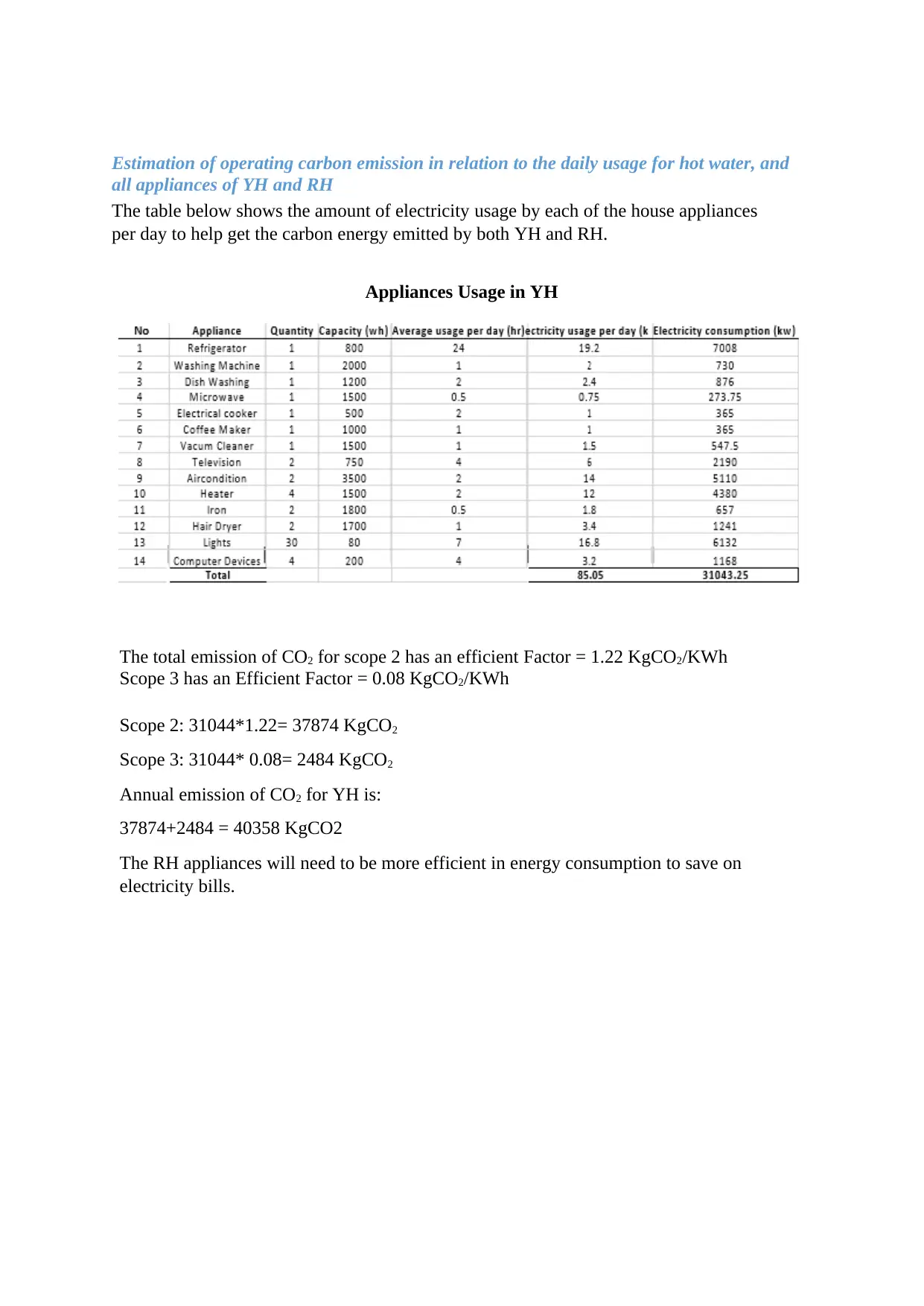
Estimation of operating carbon emission in relation to the daily usage for hot water, and
all appliances of YH and RH
The table below shows the amount of electricity usage by each of the house appliances
per day to help get the carbon energy emitted by both YH and RH.
Appliances Usage in YH
The total emission of CO2 for scope 2 has an efficient Factor = 1.22 KgCO2/KWh
Scope 3 has an Efficient Factor = 0.08 KgCO2/KWh
Scope 2: 31044*1.22= 37874 KgCO2
Scope 3: 31044* 0.08= 2484 KgCO2
Annual emission of CO2 for YH is:
37874+2484 = 40358 KgCO2
The RH appliances will need to be more efficient in energy consumption to save on
electricity bills.
all appliances of YH and RH
The table below shows the amount of electricity usage by each of the house appliances
per day to help get the carbon energy emitted by both YH and RH.
Appliances Usage in YH
The total emission of CO2 for scope 2 has an efficient Factor = 1.22 KgCO2/KWh
Scope 3 has an Efficient Factor = 0.08 KgCO2/KWh
Scope 2: 31044*1.22= 37874 KgCO2
Scope 3: 31044* 0.08= 2484 KgCO2
Annual emission of CO2 for YH is:
37874+2484 = 40358 KgCO2
The RH appliances will need to be more efficient in energy consumption to save on
electricity bills.

The calculation in two scopes will be the same as the YH;
6945.95*1.22= 8474.059 KgCO2
6945.95*0.08= 555.6 KgCO2
8474.059 +555.6 = 9029.659 KgCO2
6945.95*1.22= 8474.059 KgCO2
6945.95*0.08= 555.6 KgCO2
8474.059 +555.6 = 9029.659 KgCO2
Paraphrase This Document
Need a fresh take? Get an instant paraphrase of this document with our AI Paraphraser
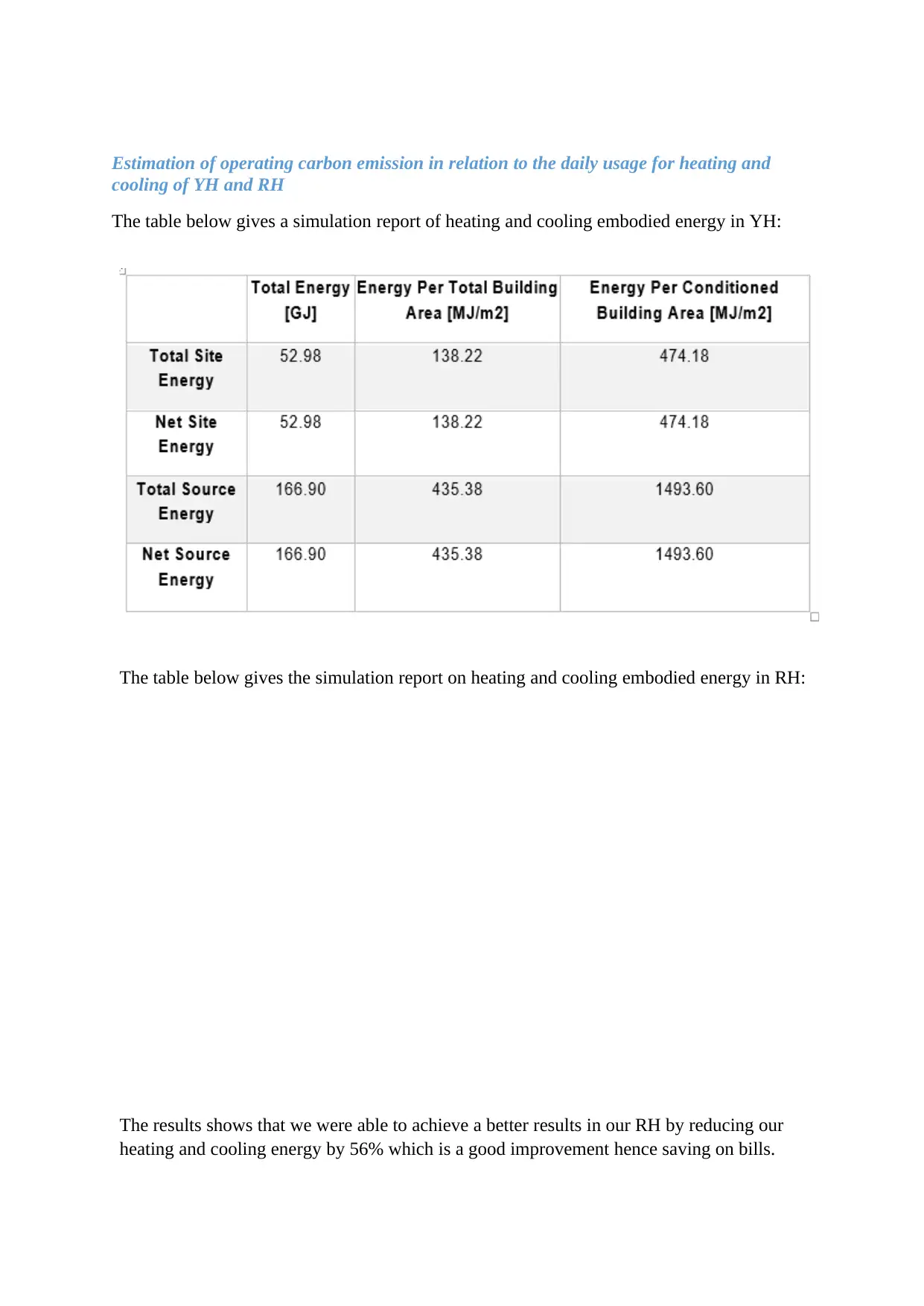
Estimation of operating carbon emission in relation to the daily usage for heating and
cooling of YH and RH
The table below gives a simulation report of heating and cooling embodied energy in YH:
The table below gives the simulation report on heating and cooling embodied energy in RH:
The results shows that we were able to achieve a better results in our RH by reducing our
heating and cooling energy by 56% which is a good improvement hence saving on bills.
cooling of YH and RH
The table below gives a simulation report of heating and cooling embodied energy in YH:
The table below gives the simulation report on heating and cooling embodied energy in RH:
The results shows that we were able to achieve a better results in our RH by reducing our
heating and cooling energy by 56% which is a good improvement hence saving on bills.

HTML tables extracted from energy plus are shown below
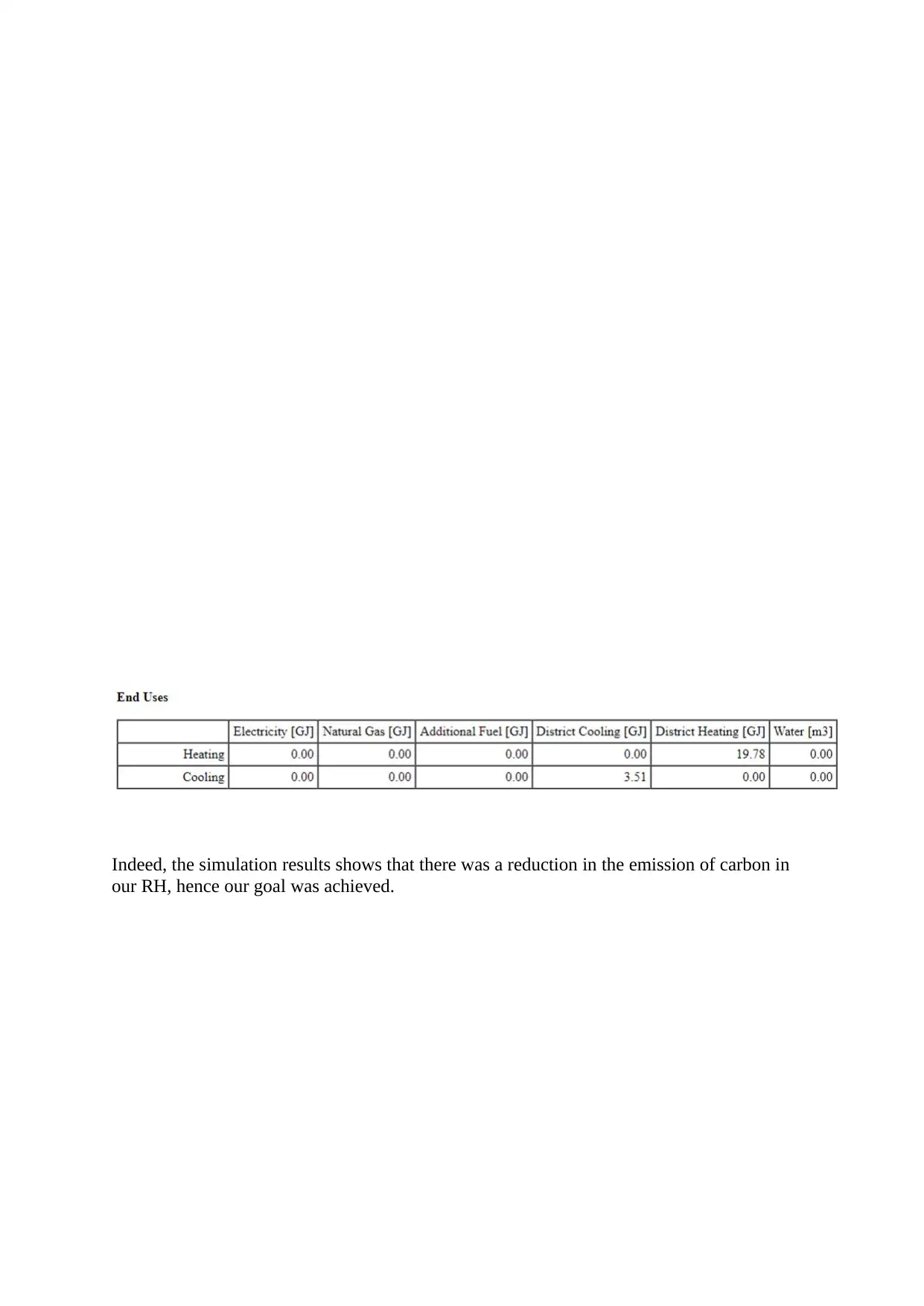
Indeed, the simulation results shows that there was a reduction in the emission of carbon in
our RH, hence our goal was achieved.
our RH, hence our goal was achieved.
Secure Best Marks with AI Grader
Need help grading? Try our AI Grader for instant feedback on your assignments.
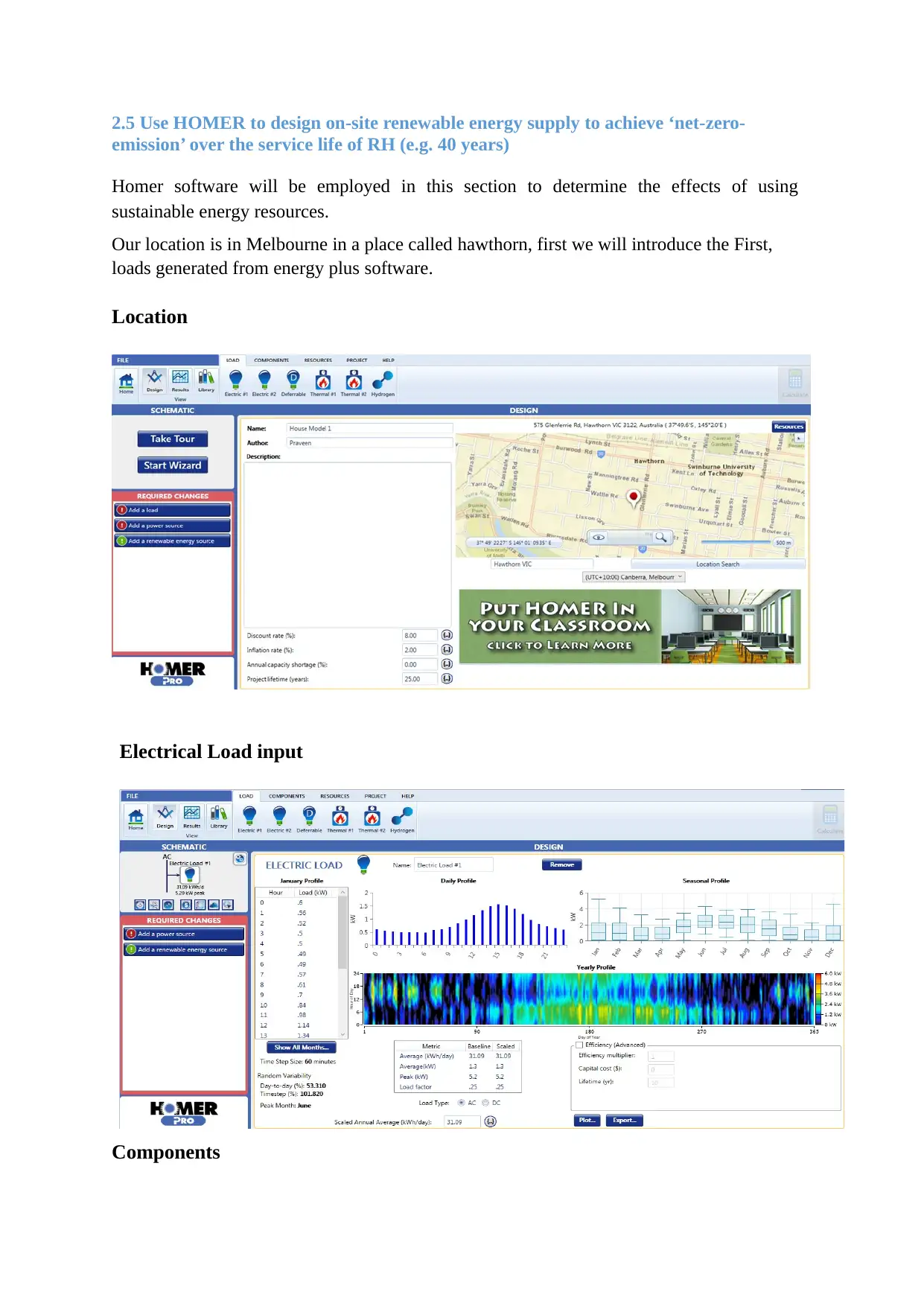
2.5 Use HOMER to design on-site renewable energy supply to achieve ‘net-zero-
emission’ over the service life of RH (e.g. 40 years)
Homer software will be employed in this section to determine the effects of using
sustainable energy resources.
Our location is in Melbourne in a place called hawthorn, first we will introduce the First,
loads generated from energy plus software.
Location
Electrical Load input
Components
emission’ over the service life of RH (e.g. 40 years)
Homer software will be employed in this section to determine the effects of using
sustainable energy resources.
Our location is in Melbourne in a place called hawthorn, first we will introduce the First,
loads generated from energy plus software.
Location
Electrical Load input
Components

Grid system
PV system
It shows the cost of installation, replacement and O&M per year.
Converter
PV system
It shows the cost of installation, replacement and O&M per year.
Converter
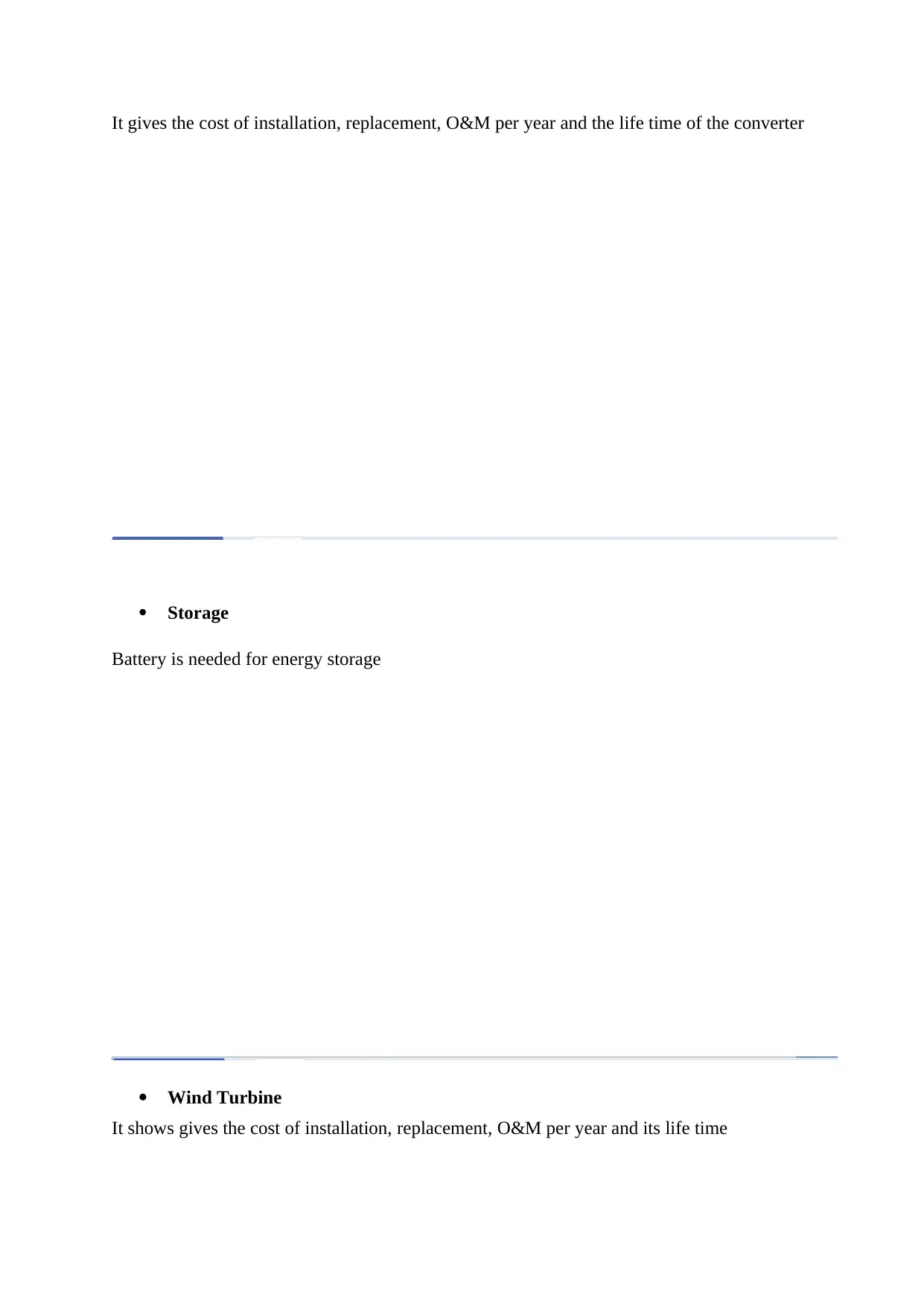
It gives the cost of installation, replacement, O&M per year and the life time of the converter
Storage
Battery is needed for energy storage
Wind Turbine
It shows gives the cost of installation, replacement, O&M per year and its life time
Storage
Battery is needed for energy storage
Wind Turbine
It shows gives the cost of installation, replacement, O&M per year and its life time
Paraphrase This Document
Need a fresh take? Get an instant paraphrase of this document with our AI Paraphraser
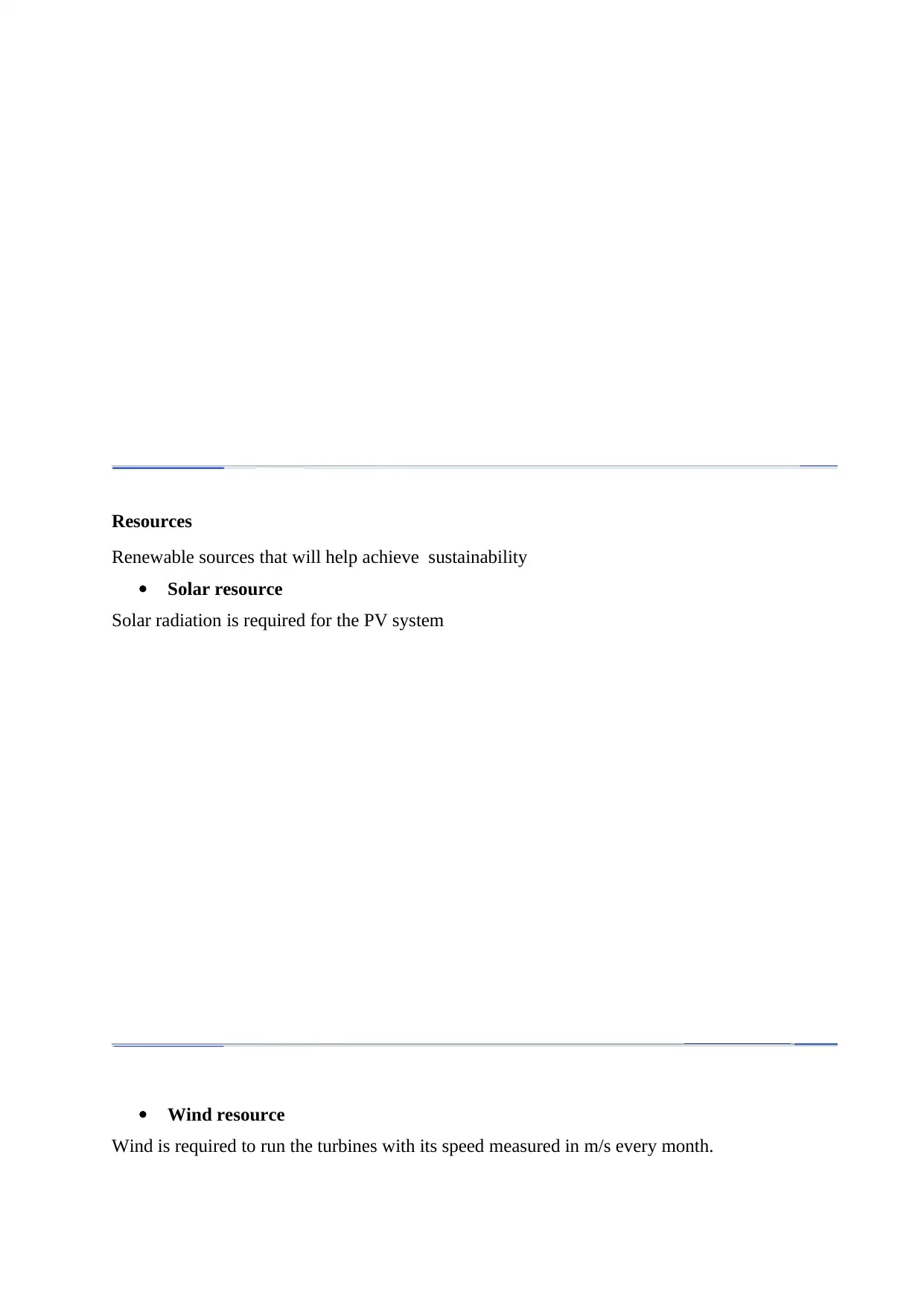
Resources
Renewable sources that will help achieve sustainability
Solar resource
Solar radiation is required for the PV system
Wind resource
Wind is required to run the turbines with its speed measured in m/s every month.
Renewable sources that will help achieve sustainability
Solar resource
Solar radiation is required for the PV system
Wind resource
Wind is required to run the turbines with its speed measured in m/s every month.

Project detail
Economic
Simulation Results
Economic
Simulation Results

Cost Summary
Secure Best Marks with AI Grader
Need help grading? Try our AI Grader for instant feedback on your assignments.
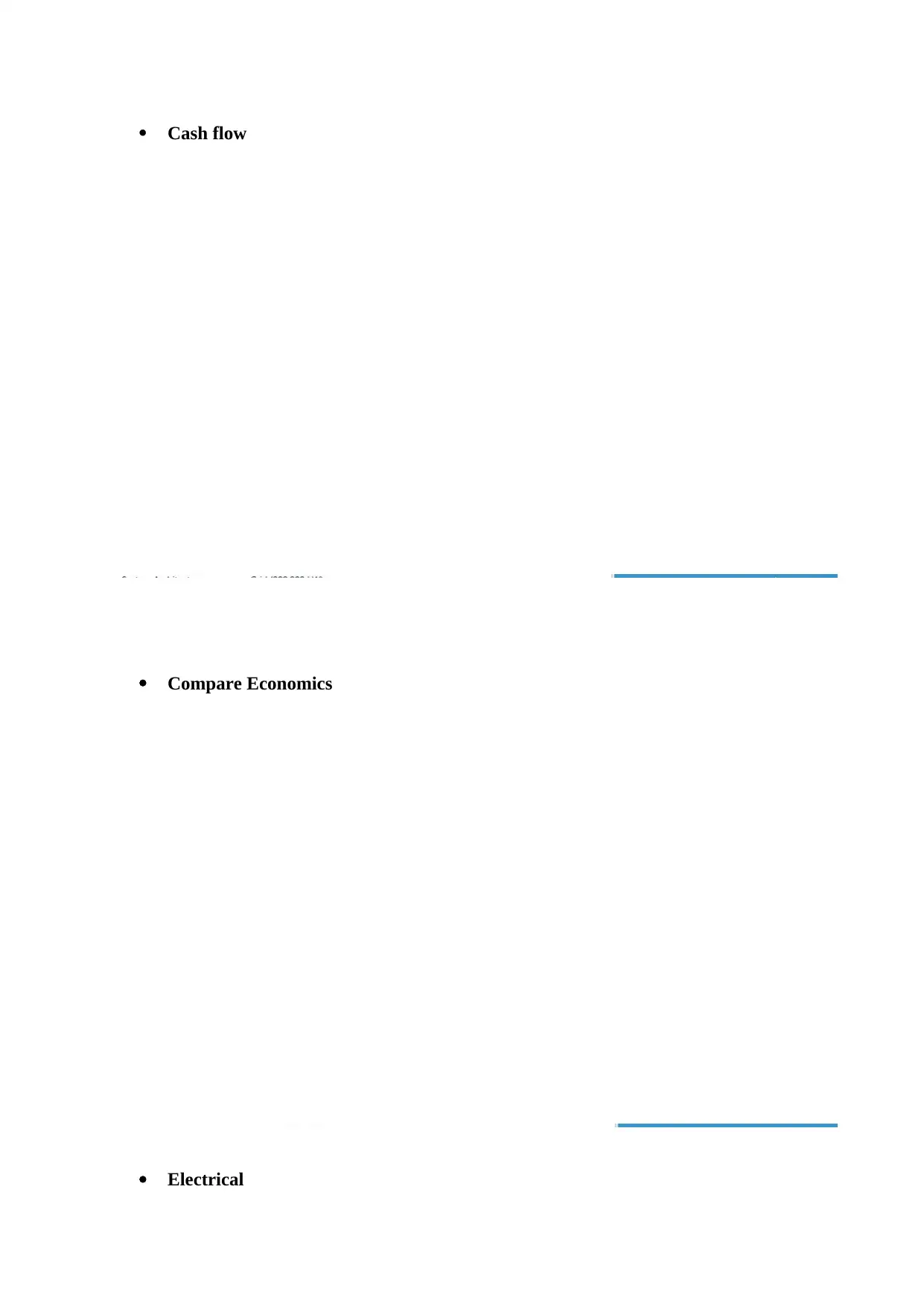
Cash flow
Compare Economics
Electrical
Compare Economics
Electrical
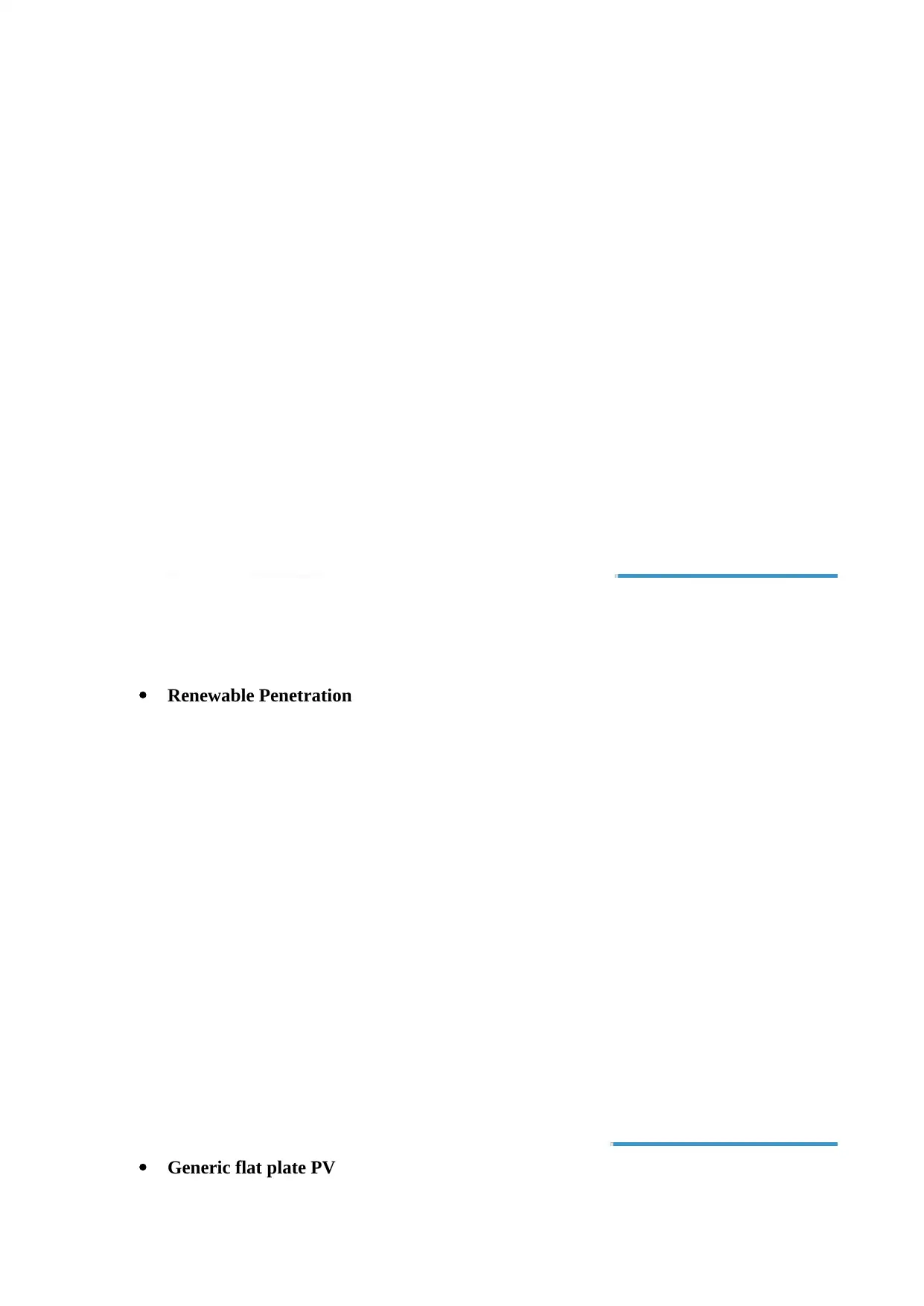
Renewable Penetration
Generic flat plate PV
Generic flat plate PV

Grid
System Converter
System Converter
Paraphrase This Document
Need a fresh take? Get an instant paraphrase of this document with our AI Paraphraser

Emission
This results shows that 40 years of life service of the RH gives a net cost of $48, 020.40
This results shows that 40 years of life service of the RH gives a net cost of $48, 020.40
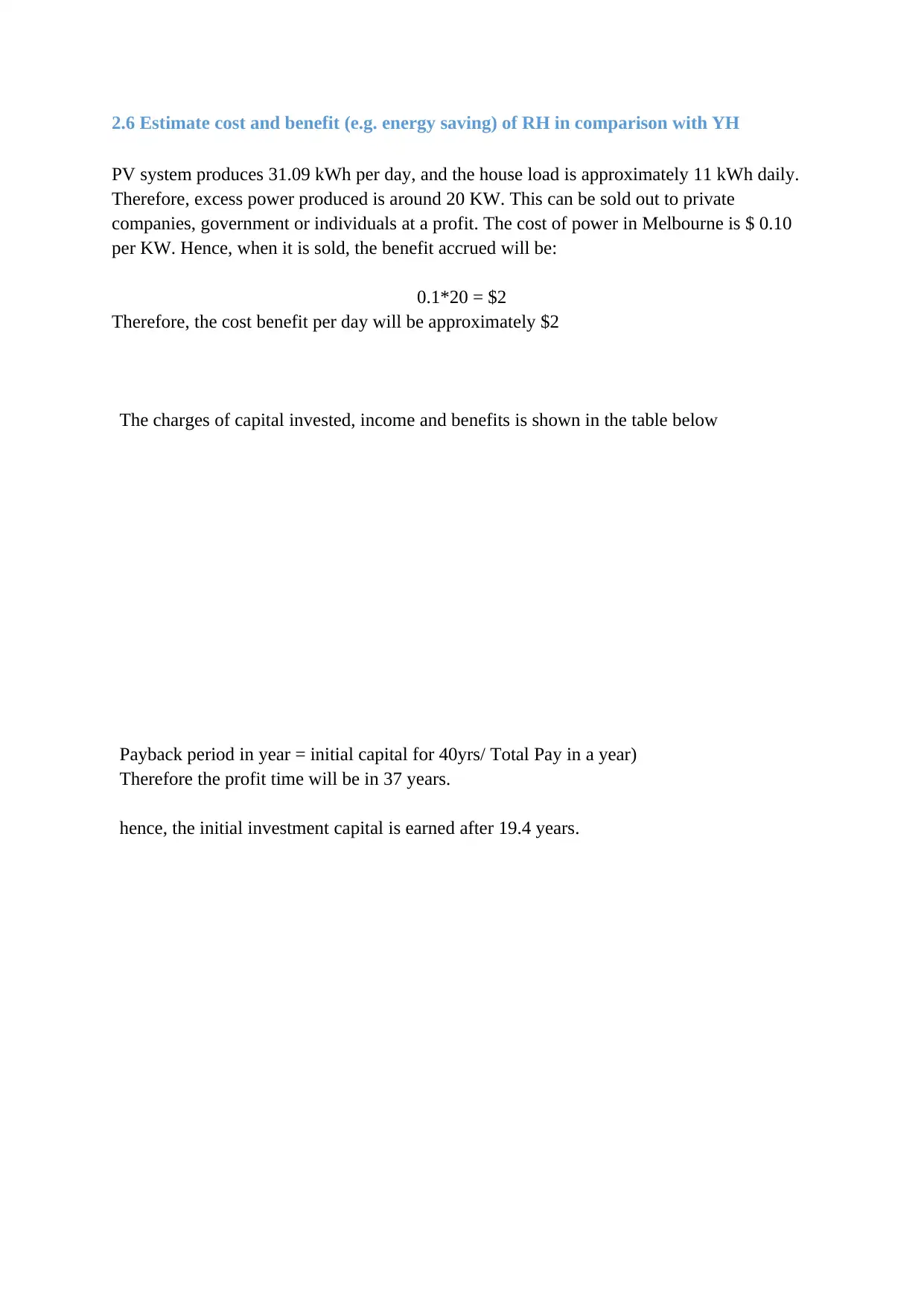
2.6 Estimate cost and benefit (e.g. energy saving) of RH in comparison with YH
PV system produces 31.09 kWh per day, and the house load is approximately 11 kWh daily.
Therefore, excess power produced is around 20 KW. This can be sold out to private
companies, government or individuals at a profit. The cost of power in Melbourne is $ 0.10
per KW. Hence, when it is sold, the benefit accrued will be:
0.1*20 = $2
Therefore, the cost benefit per day will be approximately $2
The charges of capital invested, income and benefits is shown in the table below
Payback period in year = initial capital for 40yrs/ Total Pay in a year)
Therefore the profit time will be in 37 years.
hence, the initial investment capital is earned after 19.4 years.
PV system produces 31.09 kWh per day, and the house load is approximately 11 kWh daily.
Therefore, excess power produced is around 20 KW. This can be sold out to private
companies, government or individuals at a profit. The cost of power in Melbourne is $ 0.10
per KW. Hence, when it is sold, the benefit accrued will be:
0.1*20 = $2
Therefore, the cost benefit per day will be approximately $2
The charges of capital invested, income and benefits is shown in the table below
Payback period in year = initial capital for 40yrs/ Total Pay in a year)
Therefore the profit time will be in 37 years.
hence, the initial investment capital is earned after 19.4 years.
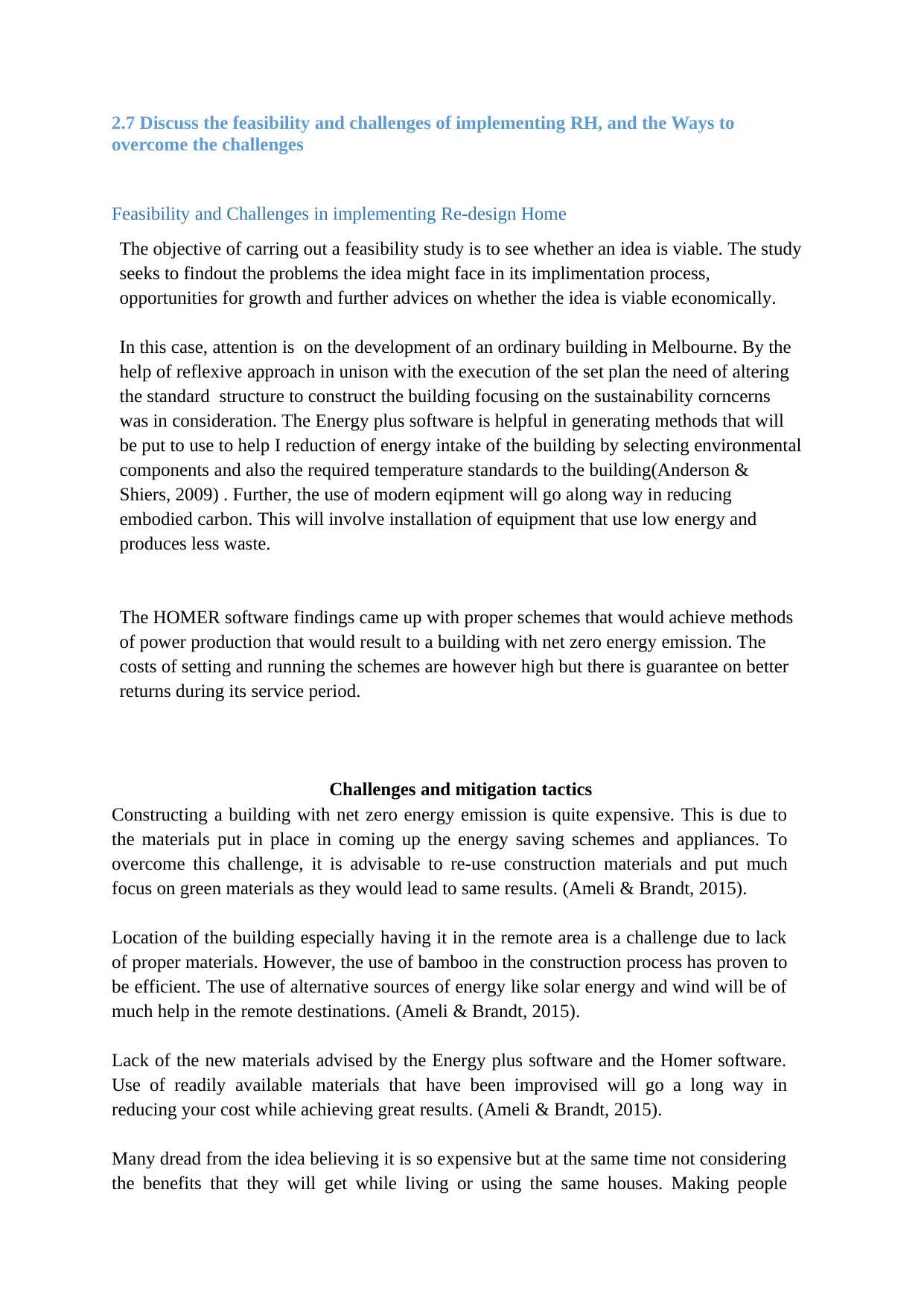
2.7 Discuss the feasibility and challenges of implementing RH, and the Ways to
overcome the challenges
Feasibility and Challenges in implementing Re-design Home
The objective of carring out a feasibility study is to see whether an idea is viable. The study
seeks to findout the problems the idea might face in its implimentation process,
opportunities for growth and further advices on whether the idea is viable economically.
In this case, attention is on the development of an ordinary building in Melbourne. By the
help of reflexive approach in unison with the execution of the set plan the need of altering
the standard structure to construct the building focusing on the sustainability corncerns
was in consideration. The Energy plus software is helpful in generating methods that will
be put to use to help I reduction of energy intake of the building by selecting environmental
components and also the required temperature standards to the building(Anderson &
Shiers, 2009) . Further, the use of modern eqipment will go along way in reducing
embodied carbon. This will involve installation of equipment that use low energy and
produces less waste.
The HOMER software findings came up with proper schemes that would achieve methods
of power production that would result to a building with net zero energy emission. The
costs of setting and running the schemes are however high but there is guarantee on better
returns during its service period.
Challenges and mitigation tactics
Constructing a building with net zero energy emission is quite expensive. This is due to
the materials put in place in coming up the energy saving schemes and appliances. To
overcome this challenge, it is advisable to re-use construction materials and put much
focus on green materials as they would lead to same results. (Ameli & Brandt, 2015).
Location of the building especially having it in the remote area is a challenge due to lack
of proper materials. However, the use of bamboo in the construction process has proven to
be efficient. The use of alternative sources of energy like solar energy and wind will be of
much help in the remote destinations. (Ameli & Brandt, 2015).
Lack of the new materials advised by the Energy plus software and the Homer software.
Use of readily available materials that have been improvised will go a long way in
reducing your cost while achieving great results. (Ameli & Brandt, 2015).
Many dread from the idea believing it is so expensive but at the same time not considering
the benefits that they will get while living or using the same houses. Making people
overcome the challenges
Feasibility and Challenges in implementing Re-design Home
The objective of carring out a feasibility study is to see whether an idea is viable. The study
seeks to findout the problems the idea might face in its implimentation process,
opportunities for growth and further advices on whether the idea is viable economically.
In this case, attention is on the development of an ordinary building in Melbourne. By the
help of reflexive approach in unison with the execution of the set plan the need of altering
the standard structure to construct the building focusing on the sustainability corncerns
was in consideration. The Energy plus software is helpful in generating methods that will
be put to use to help I reduction of energy intake of the building by selecting environmental
components and also the required temperature standards to the building(Anderson &
Shiers, 2009) . Further, the use of modern eqipment will go along way in reducing
embodied carbon. This will involve installation of equipment that use low energy and
produces less waste.
The HOMER software findings came up with proper schemes that would achieve methods
of power production that would result to a building with net zero energy emission. The
costs of setting and running the schemes are however high but there is guarantee on better
returns during its service period.
Challenges and mitigation tactics
Constructing a building with net zero energy emission is quite expensive. This is due to
the materials put in place in coming up the energy saving schemes and appliances. To
overcome this challenge, it is advisable to re-use construction materials and put much
focus on green materials as they would lead to same results. (Ameli & Brandt, 2015).
Location of the building especially having it in the remote area is a challenge due to lack
of proper materials. However, the use of bamboo in the construction process has proven to
be efficient. The use of alternative sources of energy like solar energy and wind will be of
much help in the remote destinations. (Ameli & Brandt, 2015).
Lack of the new materials advised by the Energy plus software and the Homer software.
Use of readily available materials that have been improvised will go a long way in
reducing your cost while achieving great results. (Ameli & Brandt, 2015).
Many dread from the idea believing it is so expensive but at the same time not considering
the benefits that they will get while living or using the same houses. Making people
Secure Best Marks with AI Grader
Need help grading? Try our AI Grader for instant feedback on your assignments.
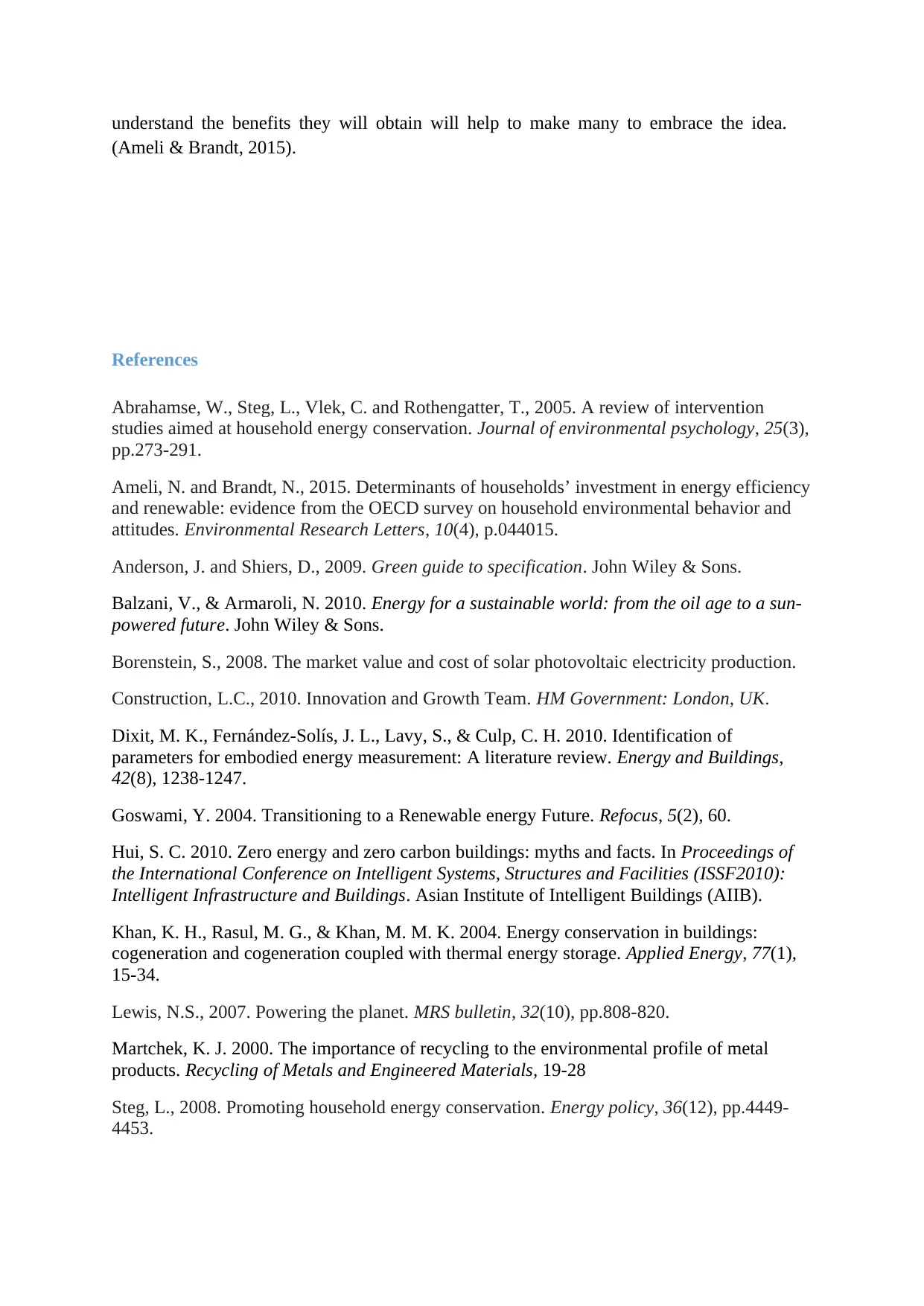
understand the benefits they will obtain will help to make many to embrace the idea.
(Ameli & Brandt, 2015).
References
Abrahamse, W., Steg, L., Vlek, C. and Rothengatter, T., 2005. A review of intervention
studies aimed at household energy conservation. Journal of environmental psychology, 25(3),
pp.273-291.
Ameli, N. and Brandt, N., 2015. Determinants of households’ investment in energy efficiency
and renewable: evidence from the OECD survey on household environmental behavior and
attitudes. Environmental Research Letters, 10(4), p.044015.
Anderson, J. and Shiers, D., 2009. Green guide to specification. John Wiley & Sons.
Balzani, V., & Armaroli, N. 2010. Energy for a sustainable world: from the oil age to a sun-
powered future. John Wiley & Sons.
Borenstein, S., 2008. The market value and cost of solar photovoltaic electricity production.
Construction, L.C., 2010. Innovation and Growth Team. HM Government: London, UK.
Dixit, M. K., Fernández-Solís, J. L., Lavy, S., & Culp, C. H. 2010. Identification of
parameters for embodied energy measurement: A literature review. Energy and Buildings,
42(8), 1238-1247.
Goswami, Y. 2004. Transitioning to a Renewable energy Future. Refocus, 5(2), 60.
Hui, S. C. 2010. Zero energy and zero carbon buildings: myths and facts. In Proceedings of
the International Conference on Intelligent Systems, Structures and Facilities (ISSF2010):
Intelligent Infrastructure and Buildings. Asian Institute of Intelligent Buildings (AIIB).
Khan, K. H., Rasul, M. G., & Khan, M. M. K. 2004. Energy conservation in buildings:
cogeneration and cogeneration coupled with thermal energy storage. Applied Energy, 77(1),
15-34.
Lewis, N.S., 2007. Powering the planet. MRS bulletin, 32(10), pp.808-820.
Martchek, K. J. 2000. The importance of recycling to the environmental profile of metal
products. Recycling of Metals and Engineered Materials, 19-28
Steg, L., 2008. Promoting household energy conservation. Energy policy, 36(12), pp.4449-
4453.
(Ameli & Brandt, 2015).
References
Abrahamse, W., Steg, L., Vlek, C. and Rothengatter, T., 2005. A review of intervention
studies aimed at household energy conservation. Journal of environmental psychology, 25(3),
pp.273-291.
Ameli, N. and Brandt, N., 2015. Determinants of households’ investment in energy efficiency
and renewable: evidence from the OECD survey on household environmental behavior and
attitudes. Environmental Research Letters, 10(4), p.044015.
Anderson, J. and Shiers, D., 2009. Green guide to specification. John Wiley & Sons.
Balzani, V., & Armaroli, N. 2010. Energy for a sustainable world: from the oil age to a sun-
powered future. John Wiley & Sons.
Borenstein, S., 2008. The market value and cost of solar photovoltaic electricity production.
Construction, L.C., 2010. Innovation and Growth Team. HM Government: London, UK.
Dixit, M. K., Fernández-Solís, J. L., Lavy, S., & Culp, C. H. 2010. Identification of
parameters for embodied energy measurement: A literature review. Energy and Buildings,
42(8), 1238-1247.
Goswami, Y. 2004. Transitioning to a Renewable energy Future. Refocus, 5(2), 60.
Hui, S. C. 2010. Zero energy and zero carbon buildings: myths and facts. In Proceedings of
the International Conference on Intelligent Systems, Structures and Facilities (ISSF2010):
Intelligent Infrastructure and Buildings. Asian Institute of Intelligent Buildings (AIIB).
Khan, K. H., Rasul, M. G., & Khan, M. M. K. 2004. Energy conservation in buildings:
cogeneration and cogeneration coupled with thermal energy storage. Applied Energy, 77(1),
15-34.
Lewis, N.S., 2007. Powering the planet. MRS bulletin, 32(10), pp.808-820.
Martchek, K. J. 2000. The importance of recycling to the environmental profile of metal
products. Recycling of Metals and Engineered Materials, 19-28
Steg, L., 2008. Promoting household energy conservation. Energy policy, 36(12), pp.4449-
4453.

Sartori, I., Napolitano, A. and Voss, K. May 2012. Net zero energy buildings: A consistent
definition framework. Buildings and Energy, 48, pp. 220-232.
Van den Bergh, J.C., 2008. Environmental regulation of households: An empirical review of
economic and psychological factors. Ecological Economics, 66(4), pp.559-574.
Yourhome.gov.au. 2017. Carbon zero, carbon positive | YourHome. [online] Available at:
http://www.yourhome.gov.au/housing/carbon-zero-carbon-positive [Accessed 2 Nov. 2017].
definition framework. Buildings and Energy, 48, pp. 220-232.
Van den Bergh, J.C., 2008. Environmental regulation of households: An empirical review of
economic and psychological factors. Ecological Economics, 66(4), pp.559-574.
Yourhome.gov.au. 2017. Carbon zero, carbon positive | YourHome. [online] Available at:
http://www.yourhome.gov.au/housing/carbon-zero-carbon-positive [Accessed 2 Nov. 2017].
1 out of 42
Related Documents
Your All-in-One AI-Powered Toolkit for Academic Success.
+13062052269
info@desklib.com
Available 24*7 on WhatsApp / Email
![[object Object]](/_next/static/media/star-bottom.7253800d.svg)
Unlock your academic potential
© 2024 | Zucol Services PVT LTD | All rights reserved.





